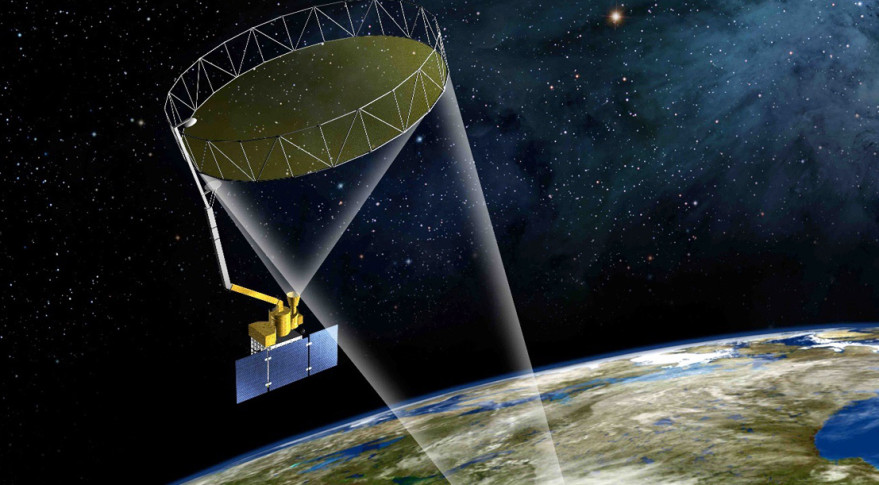Название: SMAP - Delta II 7320-10C - Vandenberg SLC-2W - 31.01.2015 - 14:22 UTC
Отправлено: Salo от 18.10.2014 12:58:48
Отправлено: Salo от 18.10.2014 12:58:48
http://spacenews.com/article/civil-space/42210nasa-soil-mapping-spacecraft-delivered-to-delta-2-launch-site
ЦитироватьNASA Soil-Mapping Spacecraft Delivered to Delta 2 Launch Site
By Dan Leone | Oct. 16, 2014(http://spacenews.com/sites/spacenews.com/files/images/articles/SMAPTruck_NASA4X3.jpg)
SMAP on Oct. 15 arrived at Vandenberg Air Force Base, California, where it will be mated with the United Launch Alliance Delta 2 rocket slated to launch it into a near-polar orbit Jan. 29. Credit: Photo courtesy of NASA
WASHINGTON — NASA's Soil Moisture Active Passive (SMAP) satellite on Oct. 15 arrived at Vandenberg Air Force Base, California, where it will be mated with the United Launch Alliance Delta 2 rocket slated to launch it into a near-polar orbit Jan. 29.
SMAP, an Earth observatory designed to produce a global map of soil moisture every two to three days over a three-year primary mission, will operate in a 685-kilometer, near-polar, sun-synchronous orbit that crosses the equator around 6 a.m. and 6 p.m. local time. SMAP will pass over the same spot every eight days. The spacecraft's synthetic aperture L-band radar and L-band radiometer will observe in a 1,000-kilometer measurement swath and gauge the moisture of the top two inches of Earth's surface, NASA said.
NASA's Jet Propulsion Laboratory in Pasadena, California, built the spacecraft and the radar, while NASA's Goddard Space Flight Center in Greenbelt, Maryland, built the radiometer. Northrop Grumman's Astro Aerospace business unit in Carpinteria, California, built a reflector boom assembly.
SMAP data will provide insight into the global water and carbon cycles, aiding weather forecasters, farmers, foresters and emergency planners, among others, according to NASA. The mission will cost around $915 million to build and launch, the U.S. Government Accountability Office said in an April report, "NASA: Assessments of Selected Large Scale Projects."
SMAP is one of the major missions endorsed by scientists in a 10-year Earth science plan known as a decadal survey the National Research Council published in 2007.
Twitter: @Leone_SN (http://twitter/Leone_SN)
Название: SMAP - Delta II 7320-10C - Vandenberg SLC-2W - 31.01.2015 - 14:22 UTC
Отправлено: Salo от 06.11.2014 10:53:54
Отправлено: Salo от 06.11.2014 10:53:54
http://spaceflightnow.com/2014/11/05/soil-moisture-mapper-fueled-for-january-launch/
ЦитироватьSoil moisture mapper fueled for January launch
Posted on November 5, 2014 by Justin Ray(https://img.novosti-kosmonavtiki.ru/154446.jpg)
Artist's concept of the SMAP spacecraft in orbit. Credit: NASA/JPL-Caltech
NASA's innovative soil moisture mapper, a new environmental satellite launching in January, has been fueled up for blastoff fr om Vandenberg Air Force Base in California.
To be carried aloft by a United Launch Alliance Delta 2 rocket, the liftoff is slated for Jan. 29 at 6:20 a.m. local time (9:20 a.m. EST; 1420 GMT).
The Soil Moisture Active Passive (SMAP) spacecraft arrived at Vandenberg in mid-October from NASA's Jet Propulsion Laboratory wh ere it was built.
"We have very little left to do at this point. The observatory is pretty much configured for flight," said Kent Kellogg, SMAP project manager at JPL.
The spacecraft has been loaded with 180 pounds of hydrazine maneuvering fuel and its software has been installed.
Fitted with an active synthetic aperture radar and passive radiometer, the data from SMAP will be used varied applications as weather forecasting to disease control.
"Our objective is to make global maps of soil moisture and also the freeze/thaw state every 2-3 days," Kellogg said.
The 2,100-pound SMAP is equipped with a 19.7-foot (6-meter) deployable mesh reflector antenna atop a boom structure that spins at 14.6 RPM and measures the planet in swaths of 620 miles (1,000 km).
"It's a large deployable structure. We've done a lot of testing on it and we feel pretty confident," Kellogg said.
http://youtu.be/RLw3veKBqo0 (http://youtu.be/RLw3veKBqo0)
Astro Aerospace, part of Northrop Grumman, builder of deployable structures and mechanisms for spaceflight produced the antenna reflector system for SMAP.
"They've built larger forms of these antennas," Kellogg said. "They are very proud to tell you that they've never had a deployment failure in space. It's a pretty elegant design and we have a lot of confidence."
The spacecraft, orbiting at altitude of 426 miles (685 km), will see through moderate vegetation, like a mature Iowa corn field, operating in daylight or darkness, to provide high-resolution maps of moisture in the soil and the state of the ground — either frozen or thawed — to give weather forecasters a better base for computer forecasting models.
What's more, the mission will help flood or drought monitoring, food productivity insights and climate science.
A two-stage Delta 2 rocket, with three strap-on solid motors, will haul the observatory into a near-polar, sun-synchronous orbit.
Officials had hoped that SMAP might launch sooner than the end of January.
"But that's looking quite unlikely at this point," Kellogg said.
"So our plan to go into a holding operation with a smaller crew doing weekly checks on the observatory, and then we mate to the launch vehicle early in January."
Название: SMAP - Delta II 7320-10C - Vandenberg SLC-2W - 31.01.2015 - 14:22 UTC
Отправлено: Vi1 от 06.11.2014 11:03:20
Отправлено: Vi1
http://www.nkj.ru/news/24973/
Название: SMAP - Delta II 7320-10C - Vandenberg SLC-2W - 31.01.2015 - 14:22 UTC
Отправлено: che wi от 02.01.2015 19:18:20
Отправлено: che wi от 02.01.2015 19:18:20
SMAP: Mapping Global Soil Moisture, Managing a Better Future
https://www.youtube.com/watch?v=C1FX5AmeD2M
https://www.youtube.com/watch?v=C1FX5AmeD2M (https://www.youtube.com/watch?v=C1FX5AmeD2M)
https://www.youtube.com/watch?v=C1FX5AmeD2M
ЦитироватьLaunching in January 2015, NASA's Soil Moisture Mapping satellite (SMAP) will track water in the soil. Data gathered with help forecast weather, floods, drought, crop yield and landslides.
https://www.youtube.com/watch?v=C1FX5AmeD2M (https://www.youtube.com/watch?v=C1FX5AmeD2M)
Название: SMAP - Delta II 7320-10C - Vandenberg SLC-2W - 31.01.2015 - 14:22 UTC
Отправлено: Salo от 09.01.2015 09:05:10
Отправлено: Salo от 09.01.2015 09:05:10
http://vz.ru/news/2015/1/9/723580.html
ЦитироватьНАСА подготовит запуск спутника высокоточного измерения влажности Земли
9 января 2015, 07:19
Специалисты НАСА готовятся к запуску научного спутника, способного определить влажность почвы на всей поверхности Земли с беспрецедентной точностью.
Аппарат должна вывести на орбиту ракета-носитель Delta-2, запуск которой с базы ВВС Ванденберг в Калифорнии запланирован на 29 января, передает ТАСС.
«Данные, которые получит эта орбитальная обсерватория, будут иметь важное значение для сельского хозяйства и метеорологии. Они окажут помощь в составлении прогнозов погоды и предсказании различных стихийных бедствий, включая засухи и наводнения», - отметила на пресс-конференции руководитель этого проекта в научном управлении НАСА Кристин Бонниксен.
Кроме того, сказала эксперт, «замеры влажности почвы позволят расширить наше представление о формировании климата», в том числе о процессе круговорота воды и его связи с энергетическим и тепловым обменом на Земле.
«В свою очередь это облегчит контроль за изменением водных ресурсов на планете, что сейчас является одной из наиболее важных экологических проблем», - добавил эксперт из Массачусетского технологического института Дара Энтекхаби.
Как рассказал сотрудник Лаборатории реактивного движения в Пассадине (штат Калифорния) Кент Келлог, с помощью своих приборов спутник будет «заглядывать» из космоса вглубь почвы на 5 см и измерять уровень ее влажности. Он также сможет определять состояние почв в районах сезонного промерзания и оттаивания.
Сделать это ему позволят радар и радиометр, которые будут дополнять друг друга и станут, по выражению Келлога, «двумя линзами в одной паре очков». Их одновременное использование обеспечит беспрецедентное разрешение и высокую точность измерений.
Первый из этих приборов оснащен вращающейся решетчатой антенной диаметром 6 метров, которая станет самым большим подобным устройством, выводившимся в космическое пространство. Благодаря ей спутник сможет вести постоянный мониторинг Земли в полосе шириной около 1 тыс. км и в течение двух-трех дней «покрывать» всю поверхность планеты.
Аппарат, снабженный солнечными батареями, должен проработать на орбите не менее трех лет. Однако, как подчеркнул представитель Лаборатории реактивного движения, «запаса прочности у него хватит на гораздо больший период». Стоимость проекта вместе с расходами на запуск составит примерно 915 млн долларов.
Название: SMAP - Delta II 7320-10C - Vandenberg SLC-2W - 31.01.2015 - 14:22 UTC
Отправлено: che wi от 10.01.2015 11:59:16
Отправлено: che wi от 10.01.2015 11:59:16
Брошюра:
http://www.jpl.nasa.gov/news/press_kits/smaplaunch.pdf
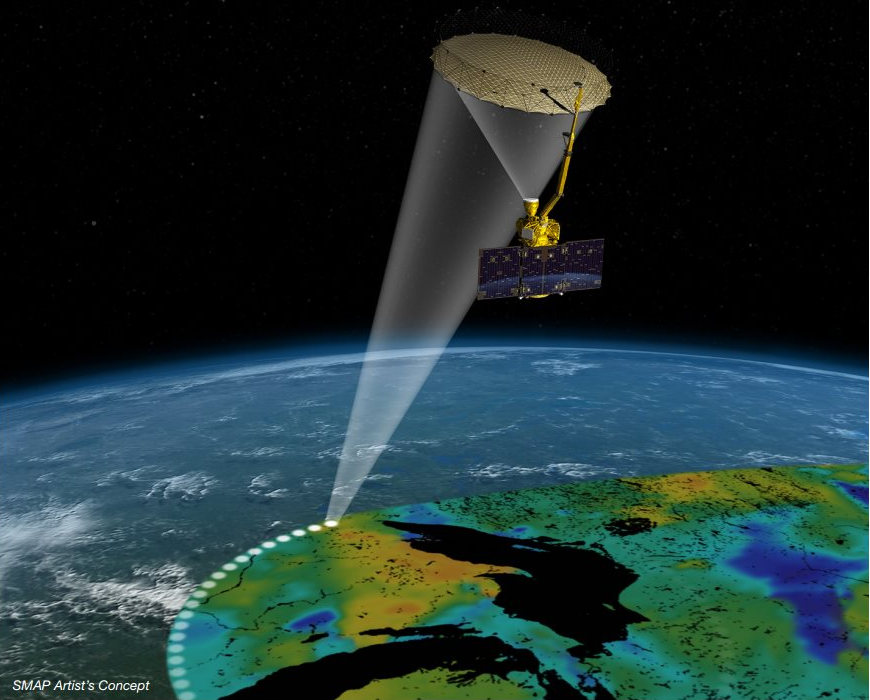
http://www.jpl.nasa.gov/news/press_kits/smaplaunch.pdf
Название: SMAP - Delta II 7320-10C - Vandenberg SLC-2W - 31.01.2015 - 14:22 UTC
Отправлено: Space Alien от 13.01.2015 07:10:01
Отправлено: Space Alien от 13.01.2015 07:10:01
ЦитироватьNASA water mapper set for move to the launch pad
Making a scientific measurement of planet Earth on a global scale never before attempted by NASA is the objective of an environment satellite to be mounted atop its booster rocket Tuesday in California.
Liftoff of the United Launch Alliance Delta 2 rocket is slated for Jan. 29 at 6:20 a.m. local time (9:20 a.m. EST; 1420 GMT).
The Soil Moisture Active Passive (SMAP) spacecraft will detect the moisture content in land surfaces and determine whether it's frozen or thawed during a three-year mission.
"The relevance is (soil moisture) is a pretty sensitive indicator of future water availability and can be used in climate models to help improve forecasts," said Kent Kellogg, the project manager for SMAP.
"One of the really nice things about this mission is we have a lot of relevance for climate science, but the data is also very useful for everyday practical applications. It will improve weather forecasting significantly, drought and flood forecasting, food productivity and diseases."
The mission was born out of first-ever Earth Science Decadal Survey in 2007, which tagged a soil moisture mission like SMAP as a high-ranking objective.
Capable of peering beneath clouds, vegetation and other surface features, the SMAP mission will produce global maps every 2-3 days.
Early Tuesday morning, crews with United Launch Alliance will carefully transport the 2,081-pound satellite from the commercial Astrotech processing facility to the pad at Space Launch Complex 2 of Vandenberg Air Force Base.
Once at the ocean-front pad, workers will lift the canister containing the observatory into the gantry for payload mating to the rocket's second stage.
A combined systems check of the rocket and spacecraft is coming up this week. The payload fairing will be installed next week.
A two-stage Delta 2 rocket, with three strap-on solid motors, will haul the observatory into a near-polar, sun-synchronous orbit.
http://spaceflightnow.com/2015/01/12/nasa-water-mapper-set-for-move-to-the-launch-pad/
Название: SMAP - Delta II 7320-10C - Vandenberg SLC-2W - 31.01.2015 - 14:22 UTC
Отправлено: che wi от 21.01.2015 19:48:56
Отправлено: che wi от 21.01.2015 19:48:56
Delta II to Launch NASA's Soil Moisture Active Passive (SMAP) Mission
http://www.ulalaunch.com/delta-ii-to-launch-nasa-smap.aspx
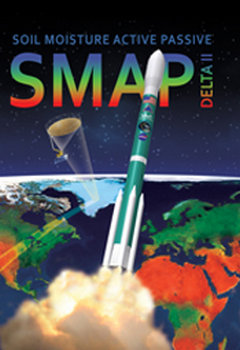
http://www.ulalaunch.com/delta-ii-to-launch-nasa-smap.aspx
ЦитироватьRocket/Payload: A United Launch Alliance Delta II 7320 will launch the Soil Moisture Active Passive (SMAP) mission for NASA.
Date/Site/Launch Time: Thursday, Jan. 29, 2015, from Space Launch Complex-2 at Vandenberg Air Force Base, California. Launch is planned for 6:20 a.m. PST.
Mission Description: SMAP will provide the most accurate, highest-resolution global measurements of soil moisture ever obtained from space and will detect whether the ground is frozen or thawed. The data will be used to enhance scientists' understanding of the processes that link Earth's water, energy and carbon cycles.
Launch Notes: SMAP will mark the 52nd Delta II mission for NASA. It will be the second of 13 planned ULA missions in 2015.
Название: SMAP - Delta II 7320-10C - Vandenberg SLC-2W - 31.01.2015 - 14:22 UTC
Отправлено: Salo от 22.01.2015 23:04:26
Отправлено: Salo от 22.01.2015 23:04:26
http://spaceflightnow.com/2015/01/22/photos-smap-joins-delta-2-rocket/
ЦитироватьPhotos: SMAP joins Delta 2 rocket
Posted on January 22, 2015 by Justin Ray (http://spaceflightnow.com/author/justin-sfn-ray/)
This photo gallery shows NASA's SMAP spacecraft arriving at the launch pad at Vandenberg Air Force Base's Space Launch Complex 2 and being hoisted atop the United Launch Alliance Delta 2 rocket. This occurred on January 13.(http://spaceflightnow.com/wp-content/uploads/2015/01/2015-1116-m.jpg)
(http://spaceflightnow.com/wp-content/uploads/2015/01/2015-1119-m.jpg)
(http://spaceflightnow.com/wp-content/uploads/2015/01/2015-1123-m.jpg)
(http://spaceflightnow.com/wp-content/uploads/2015/01/2015-1126-m.jpg)
(http://spaceflightnow.com/wp-content/uploads/2015/01/2015-1129-m.jpg)
Название: SMAP - Delta II 7320-10C - Vandenberg SLC-2W - 31.01.2015 - 14:22 UTC
Отправлено: Salo от 26.01.2015 11:58:05
Отправлено: Salo от 26.01.2015 11:58:05
http://spaceflightnow.com/2015/01/25/preview-story-launch-of-delta-2-rocket-with-nasa-probe-thursday/
ЦитироватьPreview story: Launch of Delta 2 rocket with NASA probe Thursday
Posted on January 25, 2015 by Justin Ray (http://spaceflightnow.com/author/justin-sfn-ray/)(http://spaceflightnow.com/wp-content/uploads/2015/01/preview11.jpg)
Credit: NASA
VANDENBERG AIR FORCE BASE — From weather forecasting to agricultural benefits, a new NASA mission launching this week will provide unprecedented detail, accuracy and coverage of soil moisture from space on a world-wide basis every three days for the next three years.
"Moist soil is far more interesting than you might have ever imagined," said Sam Thurman, SMAP deputy project manager.
"Soil moisture is the bank account of water in the land," added Dara Entekhabi, SMAP science definition team lead.
The $916 million Soil Moisture Active Passive (SMAP) mission is one piece of a larger program of Earth science projects in space to answer questions about how our planet works.
"SMAP will be joining our 18 operational missions that study the Earth's systems. These issues that are addressed by this are climate change, things like sea level and fresh water resources. Our on-orbit satellites, along with air and ground observations, monitor the Earth's vital signs," said Christine Bonniksen, SMAP program executive with the Science Mission Directorate's Earth Science Division at NASA Headquarters.(https://img.novosti-kosmonavtiki.ru/154463.jpg)
"I started out as a planetary science guy, which tended to have a spacecraft and large suite of instruments to go some place and do many different investigations in parallel, in part, because no one may go there again for 10-20-30 years.
"As I've come to learn in the Earth science program is that the Earth's climate is particularly complex...It takes a multitude of missions, each capable of dedicated set of measurements, and then scientists build a more comprehensive picture of our planet," said Thurman.
In the case of SMAP, the observatory's focused science goal is mapping global soil moisture content in the top two inches of the ground and determine whether that moisture is liquid or frozen.
"We have the ability to do that on a global basis and with an accuracy that is roughly 10 times greater than what's achievable with ground-based measurements today," Thurman said.
Liftoff is scheduled for the precise moment of 6:20:42 a.m. local time (9:20:42 a.m. EST; 1420:42 GMT) at the opening of a three-minute window on Thursday.
A United Launch Alliance Delta 2 rocket will serve as the launch vehicle to deliver SMAP into space. The Delta 2, making its 153rd launching, will fly in a configuration with two stages, three strap-on solid-fuel boosters and a 10-foot composite payload shroud.(https://img.novosti-kosmonavtiki.ru/154511.gif)
"The ULA team is proud to be the launch provider for NASA's Soil Moisture Active Passive (SMAP) mission," said Jim Sponnick, vice president of Atlas and Delta Programs.
"One of four first-tier missions recommended by the National Research Council's Committee on Earth Science and Applications from Space, SMAP will provide global, high- resolution mapping of soil moisture and its freeze/thaw state to link terrestrial water, energy, and carbon-cycle processes, and to extend capabilities of weather and climate prediction models."
It will take 57 minutes and two firings by the upper stage to place SMAP into its preliminary orbit of 411 by 425 miles tilted 98.1 degrees to the equator.
Also sharing the ride to orbit will be four cubesats as part of NASA's Educational Launch of Nanosatellites 10 (Elana 10) mission.
* ExoCube, a space weather satellite developed by California Polytechnic State University, San Luis Obispo, and sponsored by the National Science Foundation.
* The GEO-CAPE ROIC In-Flight Performance Experiment (GRIFEX), is a technology validation mission developed by the University of Michigan's Michigan Exploration Laboratory in partnership with NASA's Earth Science Technology Office and NASA's Jet Propulsion Laboratory.
* Focused Investigations of Relativistic Electron Burst Intensity, Range, and Dynamics II (FIREBIRD-II A and B), another space weather project, was developed by the University of New Hampshire, Montana State University, Los Alamos National Laboratory and the Aerospace Corporation.
The upper stage will deploy SMAP, then perform an engine burn that lowers the orbital altitude before systematically ejecting the cubesats one hour and 45-48 minutes after launch.
The upper stage then executes one further burn to deorbit the spent rocket body into the South Pacific.
The SMAP spacecraft, orbiting at a final science altitude of 426 miles (685 km), will see through moderate vegetation, like a mature Iowa corn field, operating in daylight or darkness, to provide high-resolution maps of moisture in the soil and the state of the ground — either frozen or thawed — to give weather forecasters a better base for computer forecasting models.(http://spaceflightnow.com/wp-content/uploads/2015/01/preview41.jpg)
Government and commercial users of the data will feed the information into weather forecasting, climate modeling, drought, landslide and flood predictions, agricultural productivity, crop yields and growing season durations, and human health issues.
"We'll return over 130 gigabytes of data every day. So if you think of a typical Netflix movie as 2-3 gigabytes, we're doing 50 Netflix movies a day," said Thurman.
SMAP is fitted with an active synthetic aperture radar and passive radiometer. It stands 16 feet tall at launch, then blossoms to 32 feet once deployed in orbit. The weight at launch is 2,081 pounds.
"The radiometer provides more accurate soil moisture but a coarse resolution of about 40 kilometers (25 miles) across," said JPL's Eni Njoku, a research scientist with SMAP. "With the radar, you can create very high resolution, but it's less accurate. To get both an accurate and a high-resolution measurement, we process the two signals together."(https://img.novosti-kosmonavtiki.ru/154519.jpg)
"These two science instruments and mission operations concept are optimized to provide high quality soil moisture data," said Entekhabi.
"The radiometer instrument acts much like a camera. It sees the ambient light environment, in this case beyond the visible range in the microwave range, and the specific advantage of the microwave range is you can see in daylight and at night, you can see through clouds, you can penetrate moderate vegetation and in fact peer into the soil for a few inches to actually measure the volume of water in the soil.
"The resolution, the size of the features on the ground that you can see with the radiometer is limited by the size of the antenna, the reflector in this case, and that's about 40 kilometers for the SMAP radiometer antenna.
"In order to augment that, SMAP carries another instrument package, which is the radar. And that one acts like a flash camera, it actually emits light, or in this case a microwave pulse, and looks at the reflection of that off the surface. And much like the flash camera, you can see a lot more detailed features on the surface. But you're susceptible to scattering off surface vegetation and surface roughness. So it's less sensitive than the radiometer to soil moisture, but it's at muchy higher resolution, on the order of 3 kilometers.
"The combination of these two is what produces the SMAP high quality soil moisture retrievals."
The radar and radiometer are like looking through both lenses of bifocals, said Bonniksen. "SMAP...will focus on the water that lives and moves through the soil. This information will improve our knowledge of weather, climate over land as well as water-related hazards," she said.
SMAP is equipped with a 19.7-foot deployable gold, lightweight, rip-resistant mesh reflector antenna atop a boom structure that spins at 14.6 rpm (one complete rotation every four seconds) and measures the planet in swaths of 620 miles.(https://img.novosti-kosmonavtiki.ru/154514.jpg)
"The antenna needs to be large in order to have high-resolution, it needs to spin because the antenna is looking off at an angle, and we spin it so that it sweeps out a circle underneath the observatory, which allows us to measure 1,000 km wide swath...to measure the entire globe every 2-3 days," said Kellogg.
On Day 16, the boom supporting the antenna will be unstowed and extended into a "tail wagging the dog" configuration. It will take 16 minutes for the 16-foot arm to unfold and lock into place.
Next, on Day 20, after a few days of monitoring the spacecraft performance in the boom deploy configuration, the antenna itself will be unfurled like a camping chair in a 33-minute procedure.
The antenna is stowed in a 12-inch-diameter, four-foot-long package for launch. Initially, it is allowed to "bloom" outward to 7-foot in diameter before being driven to the full 20-foot expanse.
http://youtu.be/qfv9h_EiJro (http://youtu.be/qfv9h_EiJro)
About 50 days after launch the spin-up sequence begins. In between, the science instruments will be checked out and the science-gathering orbital altitude will be tweaked.
The spinning initially goes to 4.5 rpm for a few days of testing before gradually stepping up to the nominal 14.6 rpm within 60 days of launch.
The nominal science mission begins 90 days after liftoff.
The spacecraft's goals of the 39-month mission include:
* Understand processes that link Earth's water, energy and carbon cycles on land.
* Estimate flows of water and energy between the atmosphere and land globally.
* Quantify the net transfer of carbon between the boreal forests and atmosphere.
* Enhance weather and climat forecasting accuracy.
* Develop improved flood prediction and drought-monitoring capability.
"What's unique about SMAP science returns is that it has returns in two very distinct areas. One of them is in fundamental understanding of how the environment works, It's addressing some fundamental Earth science questions. The second is in the arena of applications. SMAP provides data that affect our everyday lives in terms of dealing with some really serious natural hazards," said Entekhabi from the Massachusetts Institute of Technology in Cambridge.
"In terms of Earth science, there are three fundamental cycles that make lives possible on Earth. The water cycle, the energy cycle and the carbon cycle over land are linked through the soil moisture variable. If it wasn't for the soil moisture variable, these three processes over land would vary independently, but they don't. They work in concert like gears in a clock, they are linked together through the soil moisture variable."
"With the launch of this project, decision makers will be better able to understand the water cycle and how soil moisture fits into that. The soil actually gathers the precipitation prior to it entering he rivers and then evaporating back into the atmosphere. As a result, soil moisture impacts many areas of human interest, including flood, drought, disease control and weather," said Bonniksen.
See our earlier SMAP (http://spaceflightnow.com/tag/smap/) coverage.
And see our Delta archive (http://spaceflightnow.com/delta/) for further information.
Название: SMAP - Delta II 7320-10C - Vandenberg SLC-2W - 31.01.2015 - 14:22 UTC
Отправлено: Безумный Шляпник от 26.01.2015 18:51:53
Отправлено: Безумный Шляпник от 26.01.2015 18:51:53
Буклет от ULA: http://www.ulalaunch.com/uploads/docs/Mission_Booklets/DII/dii_smap_mob.pdf
Название: SMAP - Delta II 7320-10C - Vandenberg SLC-2W - 31.01.2015 - 14:22 UTC
Отправлено: Безумный Шляпник от 27.01.2015 08:14:01
Отправлено: Безумный Шляпник от 27.01.2015 08:14:01
Третья зона - очевидно, под затопление второй ступени.
HYDROPAC 278/2015 (18,83)
EASTERN NORTH PACIFIC.
SOUTH PACIFIC.
ROCKETS.
DNC 06, DNC 13.
1. HAZARDOUS OPERATIONS:
A. 1350Z TO 1524Z DAILY 29 JAN THRU 02 FEB
IN AREA BOUND BY
34-00N 120-42W, 34-05N 121-00W,
34-23N 120-53W, 34-19N 120-36W.
B. 1350Z TO 1524Z DAILY 29 JAN THRU 02 FEB
IN AREA BOUND BY
12-29N 125-46W, 12-40N 126-37W,
18-10N 125-26W, 18-00N 124-32W.
C. 1612Z TO 1635Z DAILY 29 JAN THRU 02 FEB
IN AREA BOUND BY
35-46S 162-53W, 35-46S 162-24W,
45-37S 165-44W, 45-37S 166-20W.
2. CANCEL THIS MSG 021735Z FEB 15.
( 250636Z JAN 2015 )
HYDROPAC 278/2015 (18,83)
EASTERN NORTH PACIFIC.
SOUTH PACIFIC.
ROCKETS.
DNC 06, DNC 13.
1. HAZARDOUS OPERATIONS:
A. 1350Z TO 1524Z DAILY 29 JAN THRU 02 FEB
IN AREA BOUND BY
34-00N 120-42W, 34-05N 121-00W,
34-23N 120-53W, 34-19N 120-36W.
B. 1350Z TO 1524Z DAILY 29 JAN THRU 02 FEB
IN AREA BOUND BY
12-29N 125-46W, 12-40N 126-37W,
18-10N 125-26W, 18-00N 124-32W.
C. 1612Z TO 1635Z DAILY 29 JAN THRU 02 FEB
IN AREA BOUND BY
35-46S 162-53W, 35-46S 162-24W,
45-37S 165-44W, 45-37S 166-20W.
2. CANCEL THIS MSG 021735Z FEB 15.
( 250636Z JAN 2015 )
Название: SMAP - Delta II 7320-10C - Vandenberg SLC-2W - 31.01.2015 - 14:22 UTC
Отправлено: Salo от 27.01.2015 09:45:14
Отправлено: Salo от 27.01.2015 09:45:14
http://spaceflightnow.com/2015/01/27/weather-looking-good-for-delta-2-launch/
ЦитироватьWeather looking good for Delta 2 launch
Posted on January 27, 2015 by Justin Ray (http://spaceflightnow.com/author/justin-sfn-ray/)(http://spaceflightnow.com/wp-content/uploads/2015/01/lrr1.jpg)
VANDENBERG AIR FORCE BASE — The weather outlook is 80 percent favorable for launch of the Delta 2 rocket early Thursday morning from California, with cloud thickness posing the only worry, meteorologists report.
At launch time, the forecast predicts mid- and high-level clouds, good visibility, light northeasterly winds and a temperature of 45-50 degrees F.
Mission officials will convene the Launch Readiness Review Tuesday morning at Vandenberg Air Force Base to confirm all systems are set to enter into the countdown for Thursday's liftoff.
The Launch Readiness Review will give the "go" to continue with the liftoff plans. Tuesday's meeting examines the status of the Delta rocket, the SMAP spacecraft, the network of ground support and the weather forecast. The review culminates with official consensus to press ahead with countdown operations starting Wednesday afternoon.
After the LRR concludes, the pre-launch press conference is planned for 1 p.m. local (4 p.m. EST; 2100 GMT) with the NASA launch director, ULA's program manager, SMAP officials and the weather officer.
The loading of storable propellants into the second stage was completed on Monday with the filling of hydrazine fuel. The oxidizer was loaded aboard on Friday.
Also Friday, the mission dress rehearsal was held for official personnel to practice the countdown and launch sequences.
"At this time, all pre-launch preparations are on schedule," a NASA spokesman said Monday afternoon. "There are no significant issues being worked by the launch team."
Название: SMAP - Delta II 7320-10C - Vandenberg SLC-2W - 31.01.2015 - 14:22 UTC
Отправлено: che wi от 27.01.2015 16:01:37
Отправлено: che wi от 27.01.2015 16:01:37
отсюда (http://climate.nasa.gov/blog/2228)
Название: SMAP - Delta II 7320-10C - Vandenberg SLC-2W - 31.01.2015 - 14:22 UTC
Отправлено: che wi от 28.01.2015 11:52:27
Отправлено: che wi от 28.01.2015 11:52:27
SMAP Poised to Launch on Soil Survey Flight
https://www.youtube.com/watch?v=lABnMHy5HUU
https://www.youtube.com/watch?v=lABnMHy5HUU (https://www.youtube.com/watch?v=lABnMHy5HUU)
https://www.youtube.com/watch?v=lABnMHy5HUU
https://www.youtube.com/watch?v=lABnMHy5HUU (https://www.youtube.com/watch?v=lABnMHy5HUU)
Название: SMAP - Delta II 7320-10C - Vandenberg SLC-2W - 31.01.2015 - 14:22 UTC
Отправлено: Space Alien от 29.01.2015 05:54:38
Отправлено: Space Alien от 29.01.2015 05:54:38
Название: SMAP - Delta II 7320-10C - Vandenberg SLC-2W - 31.01.2015 - 14:22 UTC
Отправлено: che wi от 29.01.2015 09:55:02
Отправлено: che wi от 29.01.2015 09:55:02
ЦитироватьATK @ATK (https://twitter.com/ATK) 1 hour ago (https://twitter.com/ATK/status/560676014213197824)
@ulalaunch (https://twitter.com/ulalaunch) 's #DeltaII (https://twitter.com/hashtag/DeltaII?src=hash) stands ready for tomorrow's early morning launch of @NASA (https://twitter.com/NASA) #SMAP (https://twitter.com/hashtag/SMAP?src=hash) satellite at 6:20 a.m. PT
Название: SMAP - Delta II 7320-10C - Vandenberg SLC-2W - 31.01.2015 - 14:22 UTC
Отправлено: che wi от 29.01.2015 10:05:00
Отправлено: che wi от 29.01.2015 10:05:00
Название: SMAP - Delta II 7320-10C - Vandenberg SLC-2W - 31.01.2015 - 14:22 UTC
Отправлено: che wi от 29.01.2015 10:19:31
Отправлено: che wi от 29.01.2015 10:19:31
NASA | SMAP Radiometer versus Radio Frequency Interference
https://www.youtube.com/watch?v=YoETi2MfJLk
https://www.youtube.com/watch?v=YoETi2MfJLk (https://www.youtube.com/watch?v=YoETi2MfJLk)
https://www.youtube.com/watch?v=YoETi2MfJLk
ЦитироватьThe microwave radiometer on NASA's Soil Moisture Active Passive (SMAP) satellite was designed and built at NASA's Goddard Space Flight Center. Along with the microwave radar, data fr om the radiometer will be used to calculate the water content of Earth's soil. Instrument Scientist Jeff Piepmeier explains the technology that Goddard incorporated in the radiometer.
All types of soil emit microwave radiation, but the amount of water changes how much of this energy is emitted. The drier the soil, the more microwave energy; the wetter the soil, the less energy.
But radio frequency interference is a problem, even though the instrument is passively listening in a region of the microwave spectrum wh ere transmission is prohibited. Some of the signals from the surrounding regions leak into the protected "listen-only" band. Goddard engineers developed new hardware and software to search for and cut out the erroneous measurements.
https://www.youtube.com/watch?v=YoETi2MfJLk (https://www.youtube.com/watch?v=YoETi2MfJLk)
Название: SMAP - Delta II 7320-10C - Vandenberg SLC-2W - 31.01.2015 - 14:22 UTC
Отправлено: che wi от 29.01.2015 13:31:51
Отправлено: che wi от 29.01.2015 13:31:51
Delta II Rocket Will Also Carry Two Tiny Twins Into Space, FIREBIRD II CubeSats
http://www.hngn.com/articles/64702/20150129/delta-ii-rocket-will-carry-two-tiny-twins-space-firebird.htm
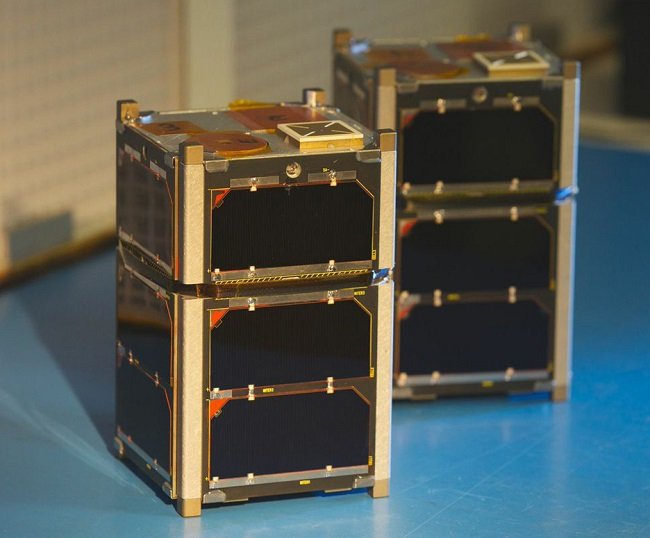
http://www.hngn.com/articles/64702/20150129/delta-ii-rocket-will-carry-two-tiny-twins-space-firebird.htm
ЦитироватьTiny twin satellites each only a little bigger than a juice box will be launched into space fr om Vandenberg Air Force Base in California at 9:20 a.m. (EST) on Thursday. The cubes were partially built by the University of New Hampshire's Space Science Center, according to a press release by the university's Institute for the Study of Earth, Oceans, and Space (EOS).
The cubes are called Focused Investigations of Relativistic Electron Burst Intensity, Range, and Dynamics (FIREBIRD II) "CubeSats." They will be added to the contents of the Delta II rocket carrying NASA's Soil Moisture Active Passive (SMAP) mission satellite.
So, what are these mini-mighty satellites going to do? They will probe an area 400 miles above Earth for a dangerous mission - investigating microbursts.
Microbursts, according to the press release, occur when electrons make quick (nearly the speed of light) - but short-lived (100 milliseconds) - bursts. Scientists believe that microbursts are the main cause of the Earth's outer radiation belt losing particles after solar storms. The storms - and resulting change in radiation - can be hazardous to technology floating in space.
"We care about this because the belts' high-energy particles, particularly the electrons, pose a real risk to spacecraft," said Harlan Spence, UNH principal investigator for the FIREBIRD II mission. "So if we understand these physical processes better, we'll be able to predict how the radiation belts will behave and both protect the satellites we depend upon for telecommunications, weather monitoring and prediction, etcetera and design them to withstand this high-energy radiation."
The original 2013 FIREBIRD mission provided the best microburst data, according to Spence, "despite the size of the spacecraft." FIREBIRD II is expected "to provide the very first characterization of the spatial scale of microbursts, without which scientists won't fully understand the global consequences of the loss of energetic particles to Earth's atmosphere," according to the press release.
"We are starting to look in the key energy range of interest between what we see with the FIREBIRD nanosatellites and what we see with the Van Allen Probes, and from those comparisons we can start learning about the physics of how particles are lost from the radiation belts to the atmosphere," Spence said, according to the press release.
The satellites will share the ride to outer space (cutting costs) and be able to go to dangerous areas wh ere bigger satellites can't. Once NASA launches them though the CubeSat Launch Initiative's Educational Launch of Nanoatellites Program, the CubeSats will be tucked away into a Poly Picosatellite Orbital Deployer (P-POD) and ejected from the Delta II. After 60 minutes, the cubes will turn on and start transmitting data, according to the press release.
The endeavor is funded by the National Science Foundation (NSF) CubeSat-based Science Missions for Geospace and Atmospheric Research Program.
Название: SMAP - Delta II 7320-10C - Vandenberg SLC-2W - 31.01.2015 - 14:22 UTC
Отправлено: che wi от 29.01.2015 14:43:36
Отправлено: che wi от 29.01.2015 14:43:36
Патчи

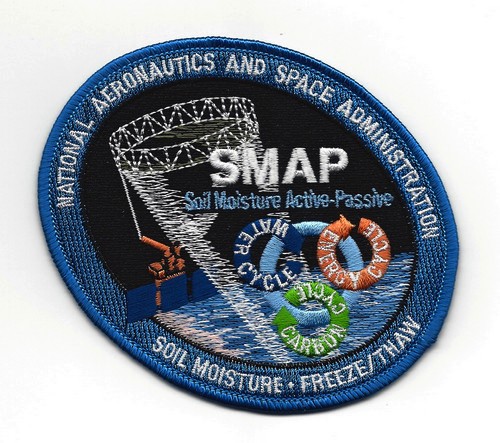
Название: SMAP - Delta II 7320-10C - Vandenberg SLC-2W - 31.01.2015 - 14:22 UTC
Отправлено: Space Alien от 29.01.2015 11:05:19
Отправлено: Space Alien от 29.01.2015 11:05:19
Трансляция НАСА началась.

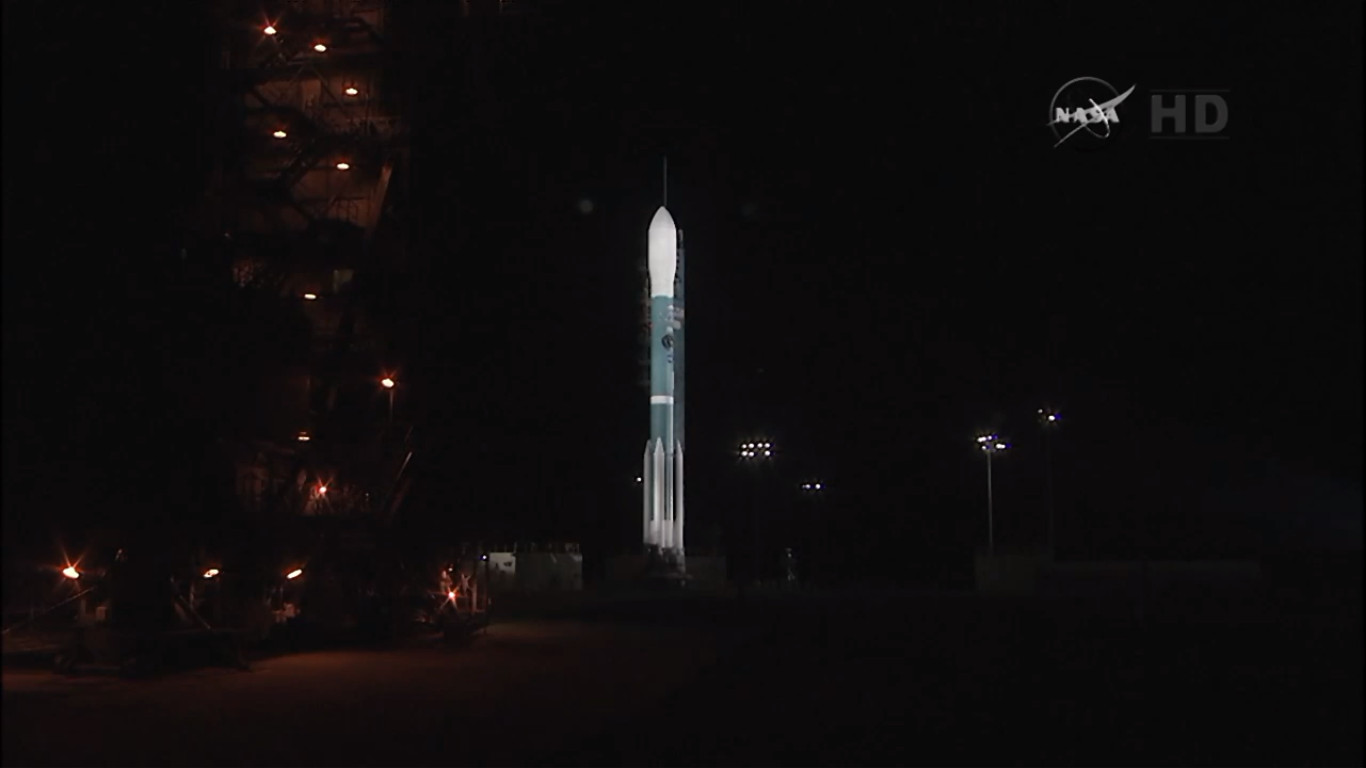
Название: SMAP - Delta II 7320-10C - Vandenberg SLC-2W - 31.01.2015 - 14:22 UTC
Отправлено: che wi от 29.01.2015 16:04:31
Отправлено: che wi от 29.01.2015 16:04:31
5:03 a.m. local (8:03 a.m. EST; 1303 GMT)
Loading of the Delta 2 rocket's first stage liquid oxygen tank has been accomplished. The process took 26 minutes today. The tank will be replenished through the countdown to replace the super-cold liquid oxygen that naturally boils away.
And now the Delta 2 rocket stands fully fueled its launch of the SMAP spacecraft at 6:20 a.m. local (9:20 a.m. EST). The vehicle's first stage was already successfully loaded with RP-1 kerosene fuel. The second stage was filled with its storable nitrogen tetroxide and Aerozine 50 fuels earlier this week. And the three strap-on booster rockets are solid-propellant.
Loading of the Delta 2 rocket's first stage liquid oxygen tank has been accomplished. The process took 26 minutes today. The tank will be replenished through the countdown to replace the super-cold liquid oxygen that naturally boils away.
And now the Delta 2 rocket stands fully fueled its launch of the SMAP spacecraft at 6:20 a.m. local (9:20 a.m. EST). The vehicle's first stage was already successfully loaded with RP-1 kerosene fuel. The second stage was filled with its storable nitrogen tetroxide and Aerozine 50 fuels earlier this week. And the three strap-on booster rockets are solid-propellant.
Название: SMAP - Delta II 7320-10C - Vandenberg SLC-2W - 31.01.2015 - 14:22 UTC
Отправлено: che wi от 29.01.2015 16:19:27
Отправлено: che wi от 29.01.2015 16:19:27
1 час до пуска
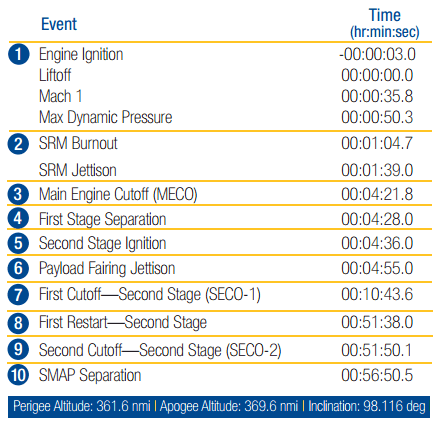
Название: SMAP - Delta II 7320-10C - Vandenberg SLC-2W - 31.01.2015 - 14:22 UTC
Отправлено: che wi от 29.01.2015 16:30:44
Отправлено: che wi от 29.01.2015 16:30:44
GRIFEX CubeSat
http://exploration.engin.umich.edu/blog/?page_id=2498
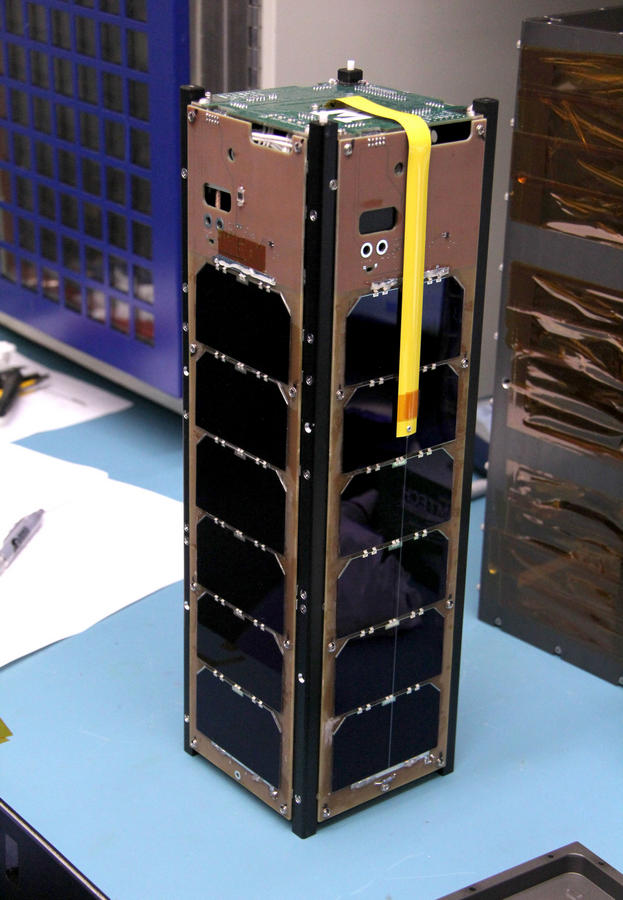
http://exploration.engin.umich.edu/blog/?page_id=2498
ЦитироватьThe GEO-CAPE ROIC In-Flight Performance Experiment (GRIFEX) is a 3U CubeSat developed by MXL that will perform engineering assessment of a JPL-developed all digital in-pixel high frame rate Read-Out Integrated Circuit (ROIC). Its high throughput capacity will enable the proposed Geostationary Coastal and Air Pollution Events (GEO-CAPE) mission concept to make hourly high spatial and spectral resolution measurements of rapidly changing atmospheric chemistry and pollution with the Panchromatic Fourier Transform Spectrometer (PanFTS) instrument in development.
GRIFEX is the fifth satellite developed by the MXL research and student team. It is the third satellite development for JPL and NASA ESTO.
Название: SMAP - Delta II 7320-10C - Vandenberg SLC-2W - 31.01.2015 - 14:22 UTC
Отправлено: che wi от 29.01.2015 16:38:32
Отправлено: che wi от 29.01.2015 16:38:32
ExoCube (CP-10) CubeSat
http://polysat.calpoly.edu/in-development/cp10-exocube/
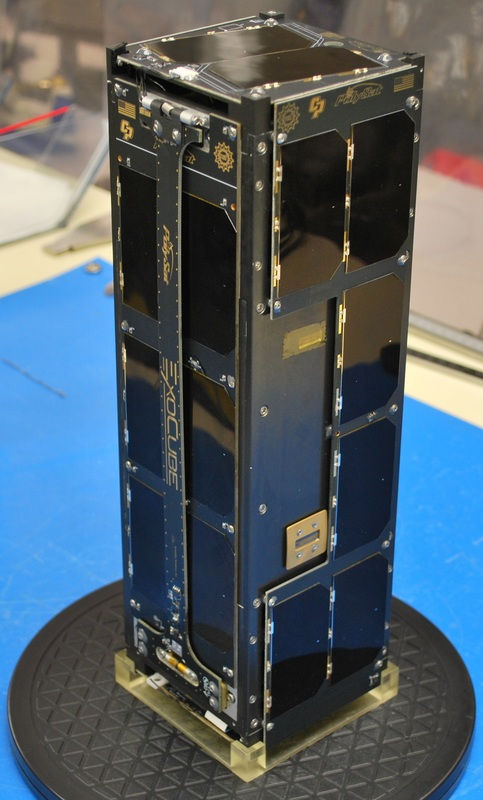
http://polysat.calpoly.edu/in-development/cp10-exocube/
ЦитироватьExoCube is a space weather satellite sponsored by the National Science Foundation. It's primary mission is to directly measure the density of Hydrogen, Oxygen, Helium and Nitrogen in the upper atmosphere. Cal Poly is designing the core satellite bus, while the scientific payload is supplied by NASA Goddard Space Flight Center (GSFC). The University of Wisconsin, Madison and Scientific Solutions, Inc. (SSI) are developing the scientific objectives and providing guidance for instrument development.
The ExoCube scientific payload includes a scientific instrument that is developed by NASA GSFC, in collaboration with University of Wisconsin, Madison, Scientific Solutions, Inc., and Cal Poly. ExoCube will characterize
- , [H], [He], [N2], [O+], [H+], [He+], [NO+], and total ion density by taking in-situ measurements within the exosphere, while taking particular interest in orbital locations above various radio observatories. ExoCube uses an active control system to point itself in the desired direction for measurements, and uses passive control to maintain this orientation.
Название: SMAP - Delta II 7320-10C - Vandenberg SLC-2W - 31.01.2015 - 14:22 UTC
Отправлено: che wi от 29.01.2015 16:41:34
Отправлено: che wi от 29.01.2015 16:41:34
Немного статистики по данному пуску:
- [/li]
- The 370th Delta rocket launch since 1960
- The 235th Delta launch with NASA involvement
- The 153rd Delta 2 rocket mission since 1989
- The 12th Delta 2 to fly in the 7320 configuration
- The 52nd Delta 2 mission overseen by NASA
- The 43rd Delta 2 rocket launch from Vandenberg AFB
- The 1st launch of the Delta family in 2015
- The 2nd United Launch Alliance flight this year
- The 93rd ULA launch overall
Название: SMAP - Delta II 7320-10C - Vandenberg SLC-2W - 31.01.2015 - 14:22 UTC
Отправлено: che wi от 29.01.2015 16:44:25
Отправлено: che wi от 29.01.2015 16:44:25
ЦитироватьSpaceflight Now @SpaceflightNow (https://twitter.com/SpaceflightNow) 1m ago (https://twitter.com/SpaceflightNow/status/560795394292977664)
Upper level winds "red" because of a wind shear at 34,000 feet. The launch of the Delta 2 and #SMAP (https://twitter.com/hashtag/SMAP?src=hash) otherwise go.
Название: SMAP - Delta II 7320-10C - Vandenberg SLC-2W - 31.01.2015 - 14:22 UTC
Отправлено: Брабонт от 29.01.2015 16:46:35
Отправлено: Брабонт от 29.01.2015 16:46:35
ЦитироватьБезумный Шляпник пишет:
Третья зона - очевидно, под затопление второй ступени.
ЦитироватьWill add extra burn for a controlled reentry for the stage for the first time on this launch of #SMAP (https://twitter.com/hashtag/SMAP?src=hash) on #DeltaII (https://twitter.com/hashtag/DeltaII?src=hash) with 4 cubsats.
Название: SMAP - Delta II 7320-10C - Vandenberg SLC-2W - 31.01.2015 - 14:22 UTC
Отправлено: che wi от 29.01.2015 16:50:32
Отправлено: che wi от 29.01.2015 16:50:32
- 30 мин
Название: SMAP - Delta II 7320-10C - Vandenberg SLC-2W - 31.01.2015 - 14:22 UTC
Отправлено: che wi от 29.01.2015 17:15:52
Отправлено: che wi от 29.01.2015 17:15:52
Пуск отложен.
Название: SMAP - Delta II 7320-10C - Vandenberg SLC-2W - 31.01.2015 - 14:22 UTC
Отправлено: che wi от 29.01.2015 17:17:27
Отправлено: che wi от 29.01.2015 17:17:27
ЦитироватьULA @ulalaunch (https://twitter.com/ulalaunch) 10 seconds ago (https://twitter.com/ulalaunch/status/560803916737421312)
We are scrubbed for the day due to upper level winds. Setting up for 24-hour turnaround.
Название: SMAP - Delta II 7320-10C - Vandenberg SLC-2W - 31.01.2015 - 14:22 UTC
Отправлено: Брабонт от 29.01.2015 17:23:09
Отправлено: Брабонт от 29.01.2015 17:23:09
На Тихоокеании сегодня нелётный день.
Название: SMAP - Delta II 7320-10C - Vandenberg SLC-2W - 31.01.2015 - 14:22 UTC
Отправлено: Iva от 29.01.2015 17:25:34
Отправлено: Iva от 29.01.2015 17:25:34
Цитироватьche wi пишет:Было бы удивительно, если бы они полетели вовремя!
Пуск отложен.
Название: SMAP - Delta II 7320-10C - Vandenberg SLC-2W - 31.01.2015 - 14:22 UTC
Отправлено: Александр Ч. от 29.01.2015 18:09:46
Отправлено: Александр Ч. от 29.01.2015 18:09:46
ЦитироватьESA Operations @esaoperations (https://twitter.com/esaoperations) 11 мин.11 минут назад (https://twitter.com/esaoperations/status/560814220237750274)Показать перевод
MT @NASA (https://twitter.com/NASA) Launch of @NASASMAP (https://twitter.com/NASASMAP) postponed due to wind. Now set for 15:20CET tmmrw TV starts 13CET http://www.nasa.gov/smap (http://t.co/JdcmgqEcT9)
Название: SMAP - Delta II 7320-10C - Vandenberg SLC-2W - 31.01.2015 - 14:22 UTC
Отправлено: Salo от 30.01.2015 09:48:25
Отправлено: Salo от 30.01.2015 09:48:25
Пуск 31 января в 17:20:42-17:23:42 ДМВ.
Название: SMAP - Delta II 7320-10C - Vandenberg SLC-2W - 31.01.2015 - 14:22 UTC
Отправлено: che wi от 30.01.2015 10:18:28
Отправлено: che wi от 30.01.2015 10:18:28
Название: SMAP - Delta II 7320-10C - Vandenberg SLC-2W - 31.01.2015 - 14:22 UTC
Отправлено: Salo от 30.01.2015 21:27:28
Отправлено: Salo от 30.01.2015 21:27:28
http://spacenews.com/nasas-smap-launch-delayed-24-hours-for-rocket-repair/
ЦитироватьNASA's SMAP Launch Delayed 24 Hours for Rocket Repair
by Dan Leone (http://spacenews.com/author/dan-leone/) — January 30, 2015
WASHINGTON — Launch of NASA's Soil Moisture Active Passive (SMAP) satellite has again been another 24 hours, this time because of an issue with the satellite's Delta 2 rocket, launch provider United Launch Alliance announced late Thursday (Jan. 29).
This is the second scrub this week for SMAP, which had to stand down Thursday morning because of high winds in the upper atmosphere. Launch from California's Vandenberg Air Force Base is now scheduled for Saturday at 6:20 a.m.local time (9:20 a.m. Eastern ).
ULA said some of the insulating material in the Delta 2 booster stage, which keeps the rocket's liquid oxygen oxidizer chilled at the cryogenic temperatures required for launch, had essentially come unglued.
"During inspections following the Jan. 29 launch attempt, minor debonds to the booster insulation were identified" ULA wrote in a statement on its website. "These insulation debonds are associated with cryogenic conditions experienced during tanking operations and a standard repair will be implemented."
SMAP is headed to a 685 kilometer near-polar sun-synchronous orbit to observe the moisture level of soil around the globe to a depth of five centimeters over a three-year primary mission.
(http://spacenews.com/wp-content/uploads/2015/01/Delta-2_SMAP_worker.jpg)
A worker is seen Jan. 28 preparing the launch gantry to be rolled back from the Delta 2 rocket with NASA's SMAP observatory onboard, at Vandenberg's Space Launch Complex 2. Credit: NASA/Bill Ingalls
Название: SMAP - Delta II 7320-10C - Vandenberg SLC-2W - 31.01.2015 - 14:22 UTC
Отправлено: Space Alien от 31.01.2015 06:41:57
Отправлено: Space Alien от 31.01.2015 06:41:57
Название: SMAP - Delta II 7320-10C - Vandenberg SLC-2W - 31.01.2015 - 14:22 UTC
Отправлено: che wi от 31.01.2015 15:00:06
Отправлено: che wi от 31.01.2015 15:00:06
Идёт трансляция:
http://www.nasa.gov/ntv
http://www.ulalaunch.com/nasa.aspx
http://www.livestream.com/spaceflightnow/
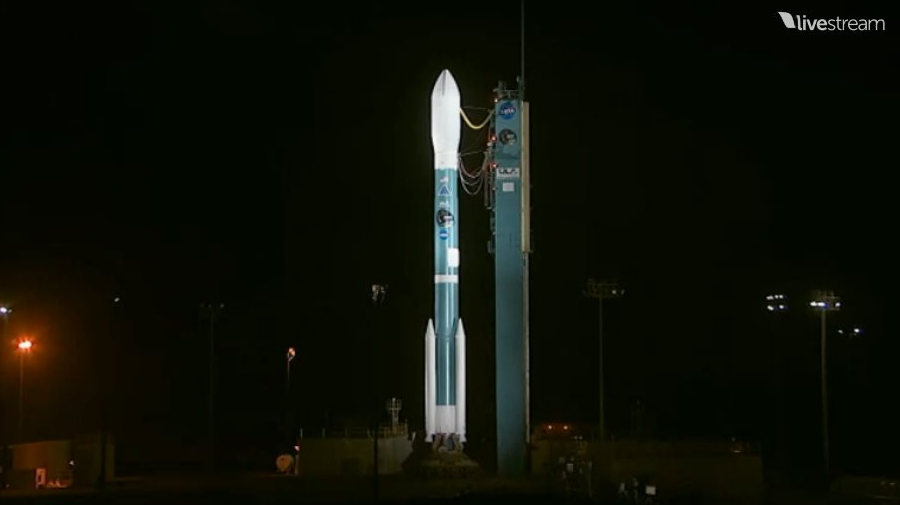
http://www.nasa.gov/ntv
http://www.ulalaunch.com/nasa.aspx
http://www.livestream.com/spaceflightnow/
Название: SMAP - Delta II 7320-10C - Vandenberg SLC-2W - 31.01.2015 - 14:22 UTC
Отправлено: che wi от 31.01.2015 15:25:44
Отправлено: che wi от 31.01.2015 15:25:44
Название: SMAP - Delta II 7320-10C - Vandenberg SLC-2W - 31.01.2015 - 14:22 UTC
Отправлено: che wi от 31.01.2015 15:27:31
Отправлено: che wi от 31.01.2015 15:27:31
Название: SMAP - Delta II 7320-10C - Vandenberg SLC-2W - 31.01.2015 - 14:22 UTC
Отправлено: che wi от 31.01.2015 15:29:03
Отправлено: che wi от 31.01.2015 15:29:03
ЦитироватьULA @ulalaunch (https://twitter.com/ulalaunch) 10 seconds ago (https://twitter.com/ulalaunch/status/561501430042071040)
Continuing to keep an eye on upper level winds. Currently red.
Название: SMAP - Delta II 7320-10C - Vandenberg SLC-2W - 31.01.2015 - 14:22 UTC
Отправлено: che wi от 31.01.2015 15:40:36
Отправлено: che wi от 31.01.2015 15:40:36
Название: SMAP - Delta II 7320-10C - Vandenberg SLC-2W - 31.01.2015 - 14:22 UTC
Отправлено: che wi от 31.01.2015 16:13:51
Отправлено: che wi от 31.01.2015 16:13:51
ЦитироватьNASA @NASA (https://twitter.com/NASA) 5 minutes ago (https://twitter.com/NASA/status/561511395234041856)
@ULALaunch (https://twitter.com/ulalaunch)'s Delta II rocket is fully fueled & ready to launch @NASASMAP (https://twitter.com/NASASMAP) at 9:20am ET.
Название: SMAP - Delta II 7320-10C - Vandenberg SLC-2W - 31.01.2015 - 14:22 UTC
Отправлено: che wi от 31.01.2015 17:05:35
Отправлено: che wi от 31.01.2015 17:05:35
Картинка с nasa.gov вроде запаздывает на секунд 10-20 по сравнению с livestream.com
Название: SMAP - Delta II 7320-10C - Vandenberg SLC-2W - 31.01.2015 - 14:22 UTC
Отправлено: che wi от 31.01.2015 17:08:16
Отправлено: che wi от 31.01.2015 17:08:16
Время пуска немного сдвинули: 14.22 UTC / 17.22 MSK
Название: SMAP - Delta II 7320-10C - Vandenberg SLC-2W - 31.01.2015 - 14:22 UTC
Отправлено: che wi от 31.01.2015 17:12:04
Отправлено: che wi от 31.01.2015 17:12:04
- 10 мин
Название: SMAP - Delta II 7320-10C - Vandenberg SLC-2W - 31.01.2015 - 14:22 UTC
Отправлено: che wi от 31.01.2015 17:12:46
Отправлено: che wi от 31.01.2015 17:12:46
ЦитироватьNASA SMAP @NASASMAP (https://twitter.com/NASASMAP) 10 seconds ago (https://twitter.com/NASASMAP/status/561527551290798080)
Upper level winds are now GREEN!
Название: SMAP - Delta II 7320-10C - Vandenberg SLC-2W - 31.01.2015 - 14:22 UTC
Отправлено: che wi от 31.01.2015 17:16:29
Отправлено: che wi от 31.01.2015 17:16:29
- 5 мин
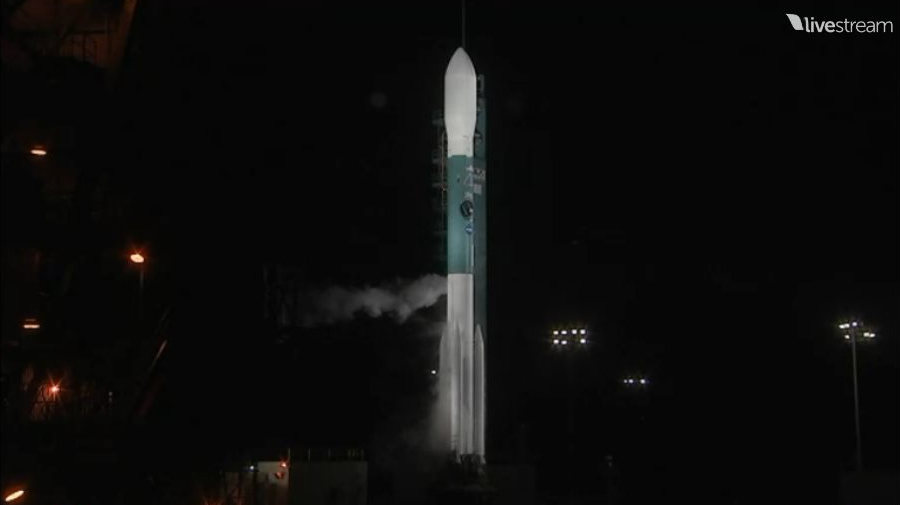
Название: SMAP - Delta II 7320-10C - Vandenberg SLC-2W - 31.01.2015 - 14:22 UTC
Отправлено: ВВК от 31.01.2015 13:16:57
Отправлено: ВВК от 31.01.2015 13:16:57
Там ночь?
Название: SMAP - Delta II 7320-10C - Vandenberg SLC-2W - 31.01.2015 - 14:22 UTC
Отправлено: che wi от 31.01.2015 17:17:12
Отправлено: che wi от 31.01.2015 17:17:12
Название: SMAP - Delta II 7320-10C - Vandenberg SLC-2W - 31.01.2015 - 14:22 UTC
Отправлено: che wi от 31.01.2015 17:18:44
Отправлено: che wi от 31.01.2015 17:18:44
Название: SMAP - Delta II 7320-10C - Vandenberg SLC-2W - 31.01.2015 - 14:22 UTC
Отправлено: ВВК от 31.01.2015 13:19:59
Отправлено: ВВК от 31.01.2015 13:19:59
-2 мин
Название: SMAP - Delta II 7320-10C - Vandenberg SLC-2W - 31.01.2015 - 14:22 UTC
Отправлено: che wi от 31.01.2015 17:20:48
Отправлено: che wi от 31.01.2015 17:20:48
ЦитироватьВВК пишет:6 утра
Там ночь?
Название: SMAP - Delta II 7320-10C - Vandenberg SLC-2W - 31.01.2015 - 14:22 UTC
Отправлено: che wi от 31.01.2015 17:21:32
Отправлено: che wi от 31.01.2015 17:21:32
Пошла.
Название: SMAP - Delta II 7320-10C - Vandenberg SLC-2W - 31.01.2015 - 14:22 UTC
Отправлено: Salo от 31.01.2015 17:22:08
Отправлено: Salo от 31.01.2015 17:22:08
Улетела!
Название: SMAP - Delta II 7320-10C - Vandenberg SLC-2W - 31.01.2015 - 14:22 UTC
Отправлено: che wi от 31.01.2015 17:23:32
Отправлено: che wi от 31.01.2015 17:23:32
Отделение бустеров
Название: SMAP - Delta II 7320-10C - Vandenberg SLC-2W - 31.01.2015 - 14:22 UTC
Отправлено: che wi от 31.01.2015 17:24:10
Отправлено: che wi от 31.01.2015 17:24:10
Название: SMAP - Delta II 7320-10C - Vandenberg SLC-2W - 31.01.2015 - 14:22 UTC
Отправлено: che wi от 31.01.2015 17:25:31
Отправлено: che wi от 31.01.2015 17:25:31
Название: SMAP - Delta II 7320-10C - Vandenberg SLC-2W - 31.01.2015 - 14:22 UTC
Отправлено: che wi от 31.01.2015 17:26:06
Отправлено: che wi от 31.01.2015 17:26:06
Отделение 1 ст.
Название: SMAP - Delta II 7320-10C - Vandenberg SLC-2W - 31.01.2015 - 14:22 UTC
Отправлено: che wi от 31.01.2015 17:26:38
Отправлено: che wi от 31.01.2015 17:26:38
Сброс ГО
Название: SMAP - Delta II 7320-10C - Vandenberg SLC-2W - 31.01.2015 - 14:22 UTC
Отправлено: che wi от 31.01.2015 17:27:49
Отправлено: che wi от 31.01.2015 17:27:49
Название: SMAP - Delta II 7320-10C - Vandenberg SLC-2W - 31.01.2015 - 14:22 UTC
Отправлено: che wi от 31.01.2015 17:31:58
Отправлено: che wi от 31.01.2015 17:31:58
~ 45 мин до отделения SMAP
Название: SMAP - Delta II 7320-10C - Vandenberg SLC-2W - 31.01.2015 - 14:22 UTC
Отправлено: che wi от 31.01.2015 17:38:18
Отправлено: che wi от 31.01.2015 17:38:18
https://www.youtube.com/watch?v=sQGw2JmKQtc (https://www.youtube.com/watch?v=sQGw2JmKQtc)
Название: SMAP - Delta II 7320-10C - Vandenberg SLC-2W - 31.01.2015 - 14:22 UTC
Отправлено: Space Alien от 31.01.2015 13:45:30
Отправлено: Space Alien от 31.01.2015 13:45:30
Название: SMAP - Delta II 7320-10C - Vandenberg SLC-2W - 31.01.2015 - 14:22 UTC
Отправлено: Брабонт от 31.01.2015 17:46:22
Отправлено: Брабонт от 31.01.2015 17:46:22
NASA SMAP @NASASMAP (https://twitter.com/NASASMAP)
My current telemetry looks nominal. I'm talking to TDRS - Tracking Data Relay Satellite system.
Название: SMAP - Delta II 7320-10C - Vandenberg SLC-2W - 31.01.2015 - 14:22 UTC
Отправлено: che wi от 31.01.2015 17:56:30
Отправлено: che wi от 31.01.2015 17:56:30
Более длинное видео пуска
https://www.youtube.com/watch?v=2uNYUho0wOQ
https://www.youtube.com/watch?v=2uNYUho0wOQ (https://www.youtube.com/watch?v=2uNYUho0wOQ)
https://www.youtube.com/watch?v=2uNYUho0wOQ
https://www.youtube.com/watch?v=2uNYUho0wOQ (https://www.youtube.com/watch?v=2uNYUho0wOQ)
Название: SMAP - Delta II 7320-10C - Vandenberg SLC-2W - 31.01.2015 - 14:22 UTC
Отправлено: che wi от 31.01.2015 18:09:49
Отправлено: che wi от 31.01.2015 18:09:49
ЦитироватьNASA SMAP @NASASMAP (https://twitter.com/NASASMAP) 2 minutes ago (https://twitter.com/NASASMAP/status/561541407278911488)
Exact lift-off time was 6:22;00.1 -- one tenth a second after 6:22am PT.
Название: SMAP - Delta II 7320-10C - Vandenberg SLC-2W - 31.01.2015 - 14:22 UTC
Отправлено: che wi от 31.01.2015 18:11:47
Отправлено: che wi от 31.01.2015 18:11:47
Название: SMAP - Delta II 7320-10C - Vandenberg SLC-2W - 31.01.2015 - 14:22 UTC
Отправлено: che wi от 31.01.2015 18:18:33
Отправлено: che wi от 31.01.2015 18:18:33
Отделение SMAP
Название: SMAP - Delta II 7320-10C - Vandenberg SLC-2W - 31.01.2015 - 14:22 UTC
Отправлено: che wi от 31.01.2015 18:22:42
Отправлено: che wi от 31.01.2015 18:22:42
Название: SMAP - Delta II 7320-10C - Vandenberg SLC-2W - 31.01.2015 - 14:22 UTC
Отправлено: che wi от 31.01.2015 18:26:48
Отправлено: che wi от 31.01.2015 18:26:48
~ 40 мин. до начала отделения кубсатов
Название: SMAP - Delta II 7320-10C - Vandenberg SLC-2W - 31.01.2015 - 14:22 UTC
Отправлено: Space Alien от 31.01.2015 14:52:52
Отправлено: Space Alien от 31.01.2015 14:52:52
Мои поздравления :) !
https://www.youtube.com/watch?v=l45N4iJfWt8 (https://www.youtube.com/watch?v=l45N4iJfWt8)
https://www.youtube.com/watch?v=l45N4iJfWt8 (https://www.youtube.com/watch?v=l45N4iJfWt8)
Название: SMAP - Delta II 7320-10C - Vandenberg SLC-2W - 31.01.2015 - 14:22 UTC
Отправлено: che wi от 31.01.2015 19:07:16
Отправлено: che wi от 31.01.2015 19:07:16
ЦитироватьNASA_LSP @NASA_LSP (https://twitter.com/NASA_LSP) 3 seconds ago (https://twitter.com/NASA_LSP/status/561556349579186176)
#DeltaII (https://twitter.com/hashtag/DeltaII?src=hash) has deployed FIREBIRD-II, the first of three ELaNa X CubeSats to be deployed today!
Название: SMAP - Delta II 7320-10C - Vandenberg SLC-2W - 31.01.2015 - 14:22 UTC
Отправлено: che wi от 31.01.2015 19:09:26
Отправлено: che wi от 31.01.2015 19:09:26
ЦитироватьNASA_LSP @NASA_LSP (https://twitter.com/NASA_LSP) 30 seconds ago (https://twitter.com/NASA_LSP/status/561556827176194048)
We have deployment of GRIFEX, the second ELaNa X CubeSat project!
Название: SMAP - Delta II 7320-10C - Vandenberg SLC-2W - 31.01.2015 - 14:22 UTC
Отправлено: che wi от 31.01.2015 19:10:39
Отправлено: che wi от 31.01.2015 19:10:39
ЦитироватьNASA_LSP @NASA_LSP (https://twitter.com/NASA_LSP) 13 seconds ago (https://twitter.com/NASA_LSP/status/561557212221669378)
The third and final ELaNa X CubeSat project, ExoCube, has also deployed!
Название: SMAP - Delta II 7320-10C - Vandenberg SLC-2W - 31.01.2015 - 14:22 UTC
Отправлено: che wi от 31.01.2015 19:12:47
Отправлено: che wi от 31.01.2015 19:12:47
Теперь все КА на орбите, поздравляю!
Название: SMAP - Delta II 7320-10C - Vandenberg SLC-2W - 31.01.2015 - 14:22 UTC
Отправлено: Space Alien от 31.01.2015 15:56:28
Отправлено: Space Alien от 31.01.2015 15:56:28
Название: SMAP - Delta II 7320-10C - Vandenberg SLC-2W - 31.01.2015 - 14:22 UTC
Отправлено: che wi от 31.01.2015 20:21:00
Отправлено: che wi от 31.01.2015 20:21:00
ЦитироватьNASA SMAP @NASASMAP (https://twitter.com/NASASMAP) 16 minutes ago (https://twitter.com/NASASMAP/status/561570906053828608)
My instruments will be turned on in ~11 days. My power & solar arrays working well.
Название: SMAP - Delta II 7320-10C - Vandenberg SLC-2W - 31.01.2015 - 14:22 UTC
Отправлено: ВВК от 31.01.2015 17:31:44
Отправлено: ВВК от 31.01.2015 17:31:44
Ну тут можно только поздравить!
Название: SMAP - Delta II 7320-10C - Vandenberg SLC-2W - 31.01.2015 - 14:22 UTC
Отправлено: ВВК от 31.01.2015 17:32:34
Отправлено: ВВК от 31.01.2015 17:32:34
Интересно когда у нас такая видеоинформация станет возможна?
Название: SMAP - Delta II 7320-10C - Vandenberg SLC-2W - 31.01.2015 - 14:22 UTC
Отправлено: Безумный Шляпник от 01.02.2015 11:13:38
Отправлено: Безумный Шляпник от 01.02.2015 11:13:38
| 2015-003A, #40376 98.1°, 98.2 мин., 686 х 660 км |
| 2015-003B, #40377 99.1°, 95.7 мин., 665 х 443 км |
| 2015-003C, #40378 99.1°, 95.7 мин., 670 х 438 км |
| 2015-003D, #40379 99.1°, 95.7 мин., 669 х 439 км |
| 2015-003E, #40380 99.1°, 95.7 мин., 669 х 439 км |
Название: SMAP - Delta II 7320-10C - Vandenberg SLC-2W - 31.01.2015 - 14:22 UTC
Отправлено: Безумный Шляпник от 01.02.2015 11:14:52
Отправлено: Безумный Шляпник от 01.02.2015 11:14:52
SMAP и 4 кубсата, ступень утоплена?
Название: SMAP - Delta II 7320-10C - Vandenberg SLC-2W - 31.01.2015 - 14:22 UTC
Отправлено: Безумный Шляпник от 01.02.2015 17:21:44
Отправлено: Безумный Шляпник от 01.02.2015 17:21:44
Радиолюбительская идентификация:
40377 - FIREBIRD-2-FU3
40378 - FIREBIRD-2-FU4
40379 - GRIFEX
40380 - EXOCUBE
http://www.pe0sat.vgnet.nl/2015/elana-x-cubesats-active/
40377 - FIREBIRD-2-FU3
40378 - FIREBIRD-2-FU4
40379 - GRIFEX
40380 - EXOCUBE
http://www.pe0sat.vgnet.nl/2015/elana-x-cubesats-active/
Название: SMAP - Delta II 7320-10C - Vandenberg SLC-2W - 31.01.2015 - 14:22 UTC
Отправлено: che wi от 24.02.2015 20:46:13
Отправлено: che wi от 24.02.2015 20:46:13
ЦитироватьNASA SMAP @NASASMAP (https://twitter.com/NASASMAP) 5m ago (https://twitter.com/NASASMAP/status/570277329668153344)
Powered deployment of my reflector is underway. So far, so good. It's a slow process. #SMAP (https://twitter.com/hashtag/SMAP?src=hash) #NASA (https://twitter.com/hashtag/NASA?src=hash)
Название: SMAP - Delta II 7320-10C - Vandenberg SLC-2W - 31.01.2015 - 14:22 UTC
Отправлено: Salo от 25.02.2015 16:32:06
Отправлено: Salo от 25.02.2015 16:32:06
http://spaceflightnow.com/2015/02/25/smap-observatory-unfurls-science-antenna-structure/
ЦитироватьSMAP observatory unfurls large science antenna structure
Posted on February 25, 2015 by Justin Ray (http://spaceflightnow.com/author/justin-sfn-ray/)(http://spaceflightnow.com/wp-content/uploads/2015/02/deploy.jpg)
CAPE CANAVERAL — Deploying its marquee element in space Tuesday, NASA's new Soil Moisture Active Passive spacecraft took a major step towards realizing its science potential.
SMAP unfurled a 19.7-foot lightweight, gold, rip-resistant, mesh reflector antenna atop a boom structure that will spin at 14.6 rpm, completing one rotation every four seconds.
Having unfolded the 16-foot-long boom last week, Tuesday saw the antenna successfully extended. The deploy started at 9:21 and finished by 9:55 a.m. PST as controllers watched fr om the Jet Propulsion Laboratory.
"Fantastic. We had a very nominal deployment of the reflector," said Kent Kellogg, the SMAP project manger at JPL.
Astro Aerospace, part of Northrop Grumman, builder of deployable structures and mechanisms for spaceflight, produced the antenna reflector system for SMAP.
"Whenever you deploy a large structure like this in space it's always a challenge. Our ability to test it on the ground in the same way we deploy it in space is limited because of the gravity-offloading that is required. So this was our most significant challenge post-launch," Kellogg added.
The antenna was stowed in a 12-inch-diameter, four-foot-long package for launch. Initially, it was allowed to "bloom" outward to 7 feet in diameter before being driven by a motor and piano wire to a tight, full 20-foot expanse.
"The reflector is in good health. It has the structural stiffness properties that match almost perfectly with pre-launch predictions. That's very good news for us," Kellogg said.
Upcoming in the next month, the science instruments will be checked out and the science-gathering orbital altitude will be achieved.
"It's not a big orbit raising event, it's more circularization and some minor adjustments. The Delta 2 put us pretty close to wh ere we needed to be," Kellogg said.
In the second half of March, the spin-up sequence begins for the antenna.
The launch lock that held the spin mechanism fixed will be released on March 19. The spinning initially goes to 5 rpm on March 23 for a few days of testing before gradually stepping up to the nominal 14.6 rpm on March 26.
"Once we get everything spun up and operating, that'll be another big milestone for us. We look forward to starting to get some of our science data down and processed, and seeing just how good the data ultimately will be for soil moisture and freeze/thaw state," Kellogg said.
SMAP was carried into space Jan. 31 atop a United Launch Alliance Delta 2 rocket from Vandenberg Air Force Base, California. The three-year mission will measure the the moisture content in the top two inches of soil on a global scale.
"SMAP, or as we call it the Soil Moisture Active Passive project, will be monitoring the water that lives and moves through the soil," said Christine Bonniksen, SMAP program executive at NASA Headquarters
"Soil moisture is a key part of the three cycles that support life on this planet — the water cycle, the energy cycle and the carbon cycles," she added. "These things affect human interests — floods, drought, disease control, weather."
"This data will benefit not only scientists seeking better understanding of our planet's climate environment, but it's also a boon for weather forecasters, agriculture and water resource managers, emergency planners and policy makers," added Geoff Yoder, a deputy associate administrator at NASA's Science Mission Directorate.
"SMAP is another example how NASA is making a difference in people's lives around the world."
See our earlier SMAP (http://spaceflightnow.com/tag/smap/) coverage.
Название: SMAP - Delta II 7320-10C - Vandenberg SLC-2W - 31.01.2015 - 14:22 UTC
Отправлено: che wi от 10.03.2015 09:31:35
Отправлено: che wi от 10.03.2015 09:31:35
NASA's Soil Moisture Mapper Takes First 'SMAPshots'
http://www.nasa.gov/jpl/smap/nasas-soil-moisture-mapper-takes-first-smapshots/
http://www.nasa.gov/jpl/smap/nasas-soil-moisture-mapper-takes-first-smapshots/
Название: SMAP - Delta II 7320-10C - Vandenberg SLC-2W - 31.01.2015 - 14:22 UTC
Отправлено: che wi от 20.05.2015 12:52:12
Отправлено: che wi от 20.05.2015 12:52:12
NASA Soil Moisture Mission Begins Science Operations
http://www.nasa.gov/press-release/nasa-soil-moisture-mission-begins-science-operations
High-resolution global soil moisture map from SMAP's combined radar and radiometer instruments, acquired between May 4 and May 11, 2015, during SMAP's commissioning phase. The map has a resolution of 5.6 miles (9 kilometers) >> (http://www.nasa.gov/sites/default/files/thumbnails/image/15-099a.png)
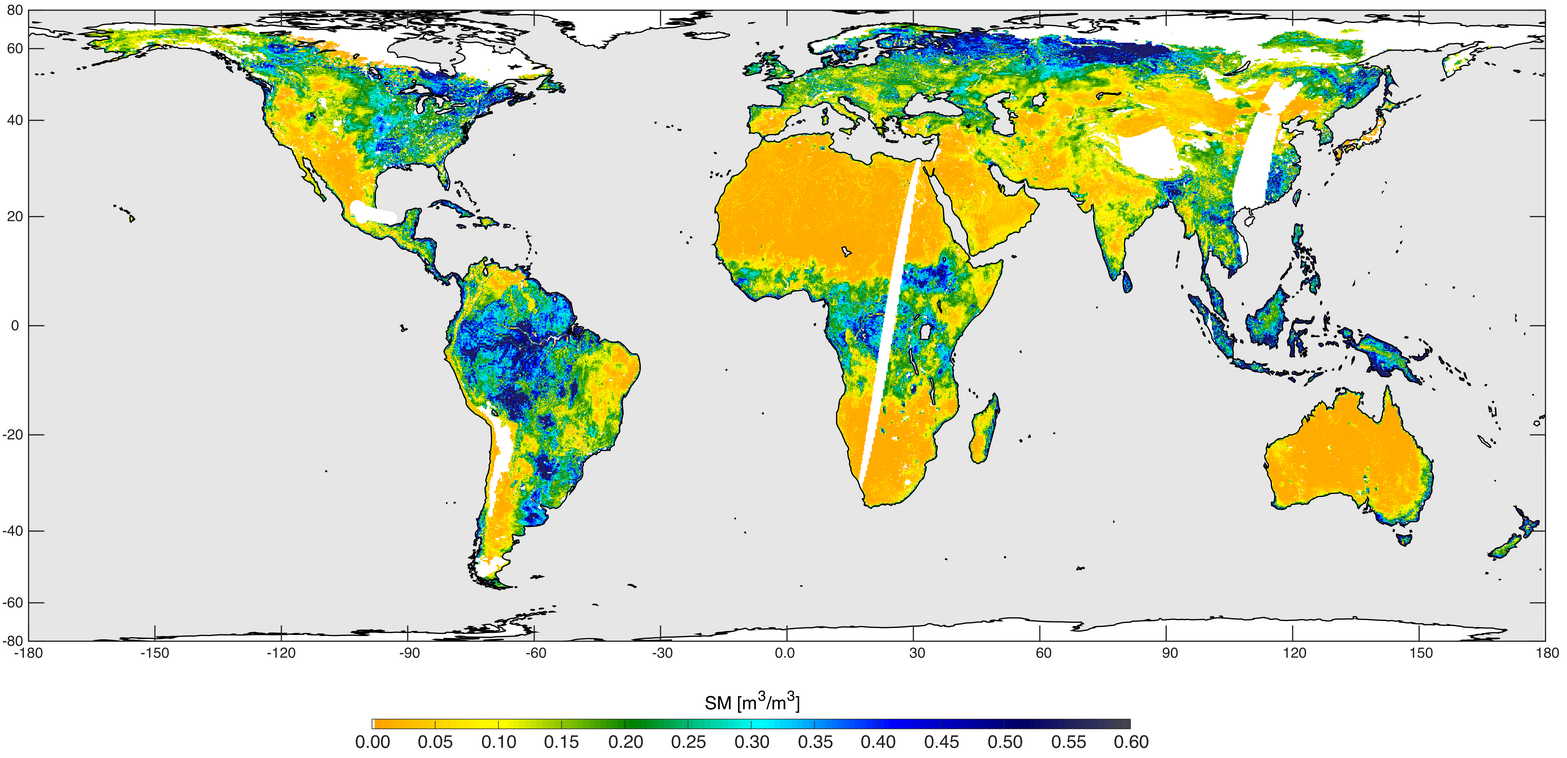
http://www.nasa.gov/press-release/nasa-soil-moisture-mission-begins-science-operations
ЦитироватьNASA's new Soil Moisture Active Passive (SMAP) mission to map global soil moisture and detect whether soils are frozen or thawed has begun science operations.
Launched Jan. 31 on a minimum three-year mission, SMAP will help scientists understand links among Earth's water, energy and carbon cycles; reduce uncertainties in predicting climate; and enhance our ability to monitor and predict natural hazards like floods and droughts. SMAP data have additional practical applications, including improved weather forecasting and crop yield predictions.
During SMAP's first three months in orbit, referred to as SMAP's "commissioning" phase, the observatory was first exposed to the space environment, its solar array and reflector boom assembly containing SMAP's 20-foot (6-meter) reflector antenna were deployed, and the antenna and instruments were spun up to their full speed, enabling global measurements every two to three days.
The commissioning phase also was used to ensure that SMAP science data reliably flow from its instruments to science data processing facilities at NASA's Jet Propulsion Laboratory (JPL) in Pasadena, California, and the agency's Goddard Space Flight Center in Greenbelt, Maryland.Спойлер
"Fourteen years after the concept for a NASA mission to map global soil moisture was first proposed, SMAP now has formally transitioned to routine science operations," said Kent Kellogg, SMAP project manager at JPL. "SMAP's science team can now begin the important task of calibrating the observatory's science data products to ensure SMAP is meeting its requirements for measurement accuracy."
Together, SMAP's two instruments, which share a common antenna, produce the highest-resolution, most accurate soil moisture maps ever obtained from space. The spacecraft's radar transmits microwave pulses to the ground and measures the strength of the signals that bounce back from Earth, whereas its radiometer measures microwaves that are naturally emitted from Earth's surface.
"SMAP data will eventually reveal how soil moisture conditions are changing over time in response to climate and how this impacts regional water availability," said Dara Entekhabi, SMAP science team leader at the Massachusetts Institute of Technology in Cambridge. "SMAP data will be combined with data from other missions like NASA's Global Precipitation Measurement, Aquarius and Gravity Recovery and Climate Experiment to reveal deeper insights into how the water cycle is evolving at global and regional scales."
The first global view of SMAP's flagship product, a combined active-passive soil moisture map with a spatial resolution of 5.6 miles (9 kilometers), shows dry conditions in the Southwestern United States and in Australia's interior. Moist soil conditions are evident in the U.S. Midwest and in eastern regions of the United States, Europe and Asia. The far northern regions depicted in these SMAP maps do not indicate soil moisture measurements because the ground there was frozen.
Zooming in on the data allows a closer look at the benefits of combining SMAP's radar and radiometer data. A few days before SMAP collected data over the central and southern United States on April 27, intense rainstorms pounded northern Texas. The areas affected by the storm in northern Texas and the Gulf Coast are visible in great detail. Such detail can be used to improve local weather forecasts, assist in monitoring drought in smaller watersheds, and forecast floods.
Over the next year, SMAP data will be calibrated and validated by comparing it against ground measurements of soil moisture and freeze/thaw state around the world at sites representing a broad spectrum of soil types, topography, vegetation and ground cover. SMAP data also will be compared with soil moisture data from existing aircraft-mounted instruments and other satellites.
Preliminary calibrated data will be available in August at designated public-access data archives, including the National Snow and Ice Data Center in Boulder, Colorado, and Alaska Satellite Facility in Fairbanks. Preliminary soil moisture and freeze/thaw products will be available in November, with validated measurements scheduled to be available for use by the general science community in the summer of 2016.
NASA uses the vantage point of space to increase our understanding of our home planet, improve lives, and safeguard our future. NASA develops new ways to observe and study Earth's interconnected natural systems with long-term data records. The agency freely shares this unique knowledge and works with institutions around the world to gain new insights into how our planet is changing.[свернуть]
High-resolution global soil moisture map from SMAP's combined radar and radiometer instruments, acquired between May 4 and May 11, 2015, during SMAP's commissioning phase. The map has a resolution of 5.6 miles (9 kilometers) >> (http://www.nasa.gov/sites/default/files/thumbnails/image/15-099a.png)
Название: SMAP - Delta II 7320-10C - Vandenberg SLC-2W - 31.01.2015 - 14:22 UTC
Отправлено: Безумный Шляпник от 11.07.2015 17:49:59
Отправлено: Безумный Шляпник от 11.07.2015 17:49:59
http://www.jpl.nasa.gov/news/news.php?feature=4658
ЦитироватьNews | July 10, 2015
SMAP Team Investigating Radar Instrument Anomaly
Mission Status Report
Mission managers at NASA's Jet Propulsion Laboratory, Pasadena, California, are assessing an anomaly with the radar instrument on NASA's Soil Moisture Active Passive (SMAP) satellite observatory. The radar is one of two science instruments on SMAP used to map global soil moisture and detect whether soils are frozen or thawed.
On July 7, at about 2:16 p.m. PDT, SMAP's radar halted its transmissions. All other components of the spacecraft continued to operate normally, including the radiometer instrument that is collecting science data.
An anomaly team has been convened at JPL and is reviewing observatory and instrument telemetry and science data. Telemetry indicates no other issues with the spacecraft.
SMAP launched Jan. 31, 2015. Its mission is to help scientists understand links among Earth's water, energy and carbon cycles; reduce uncertainties in Earth system modeling; and enhance our ability to monitor and predict natural hazards like floods and droughts. SMAP data have additional practical applications, including improved weather forecasting and crop yield predictions.
SMAP is managed for NASA's Science Mission Directorate in Washington by JPL, with instrument hardware and science contributions made by NASA's Goddard Space Flight Center in Greenbelt, Maryland. JPL built the spacecraft and is responsible for project management, system engineering, radar instrumentation, mission operations and the ground data system. Goddard is responsible for the radiometer instrument and science data products.
More information on the SMAP mission is online at:
http://www.nasa.gov/smap
Media Contact
Alan Buis
Jet Propulsion Laboratory, Pasadena, California
818-354-0474
Alan.Buis@jpl.nasa.gov
2015-237
Название: SMAP - Delta II 7320-10C - Vandenberg SLC-2W - 31.01.2015 - 14:22 UTC
Отправлено: Salo от 12.08.2015 13:30:05
Отправлено: Salo от 12.08.2015 13:30:05
http://spacenews.com/nasa-could-reboot-balky-smap-radar-in-late-august/#sthash.ZXBaoNrf.dpuf
ЦитироватьNASA Could Reboot Balky SMAP Radar In 'Late August'
by Dan Leone (http://spacenews.com/author/dan-leone/) — August 11, 2015
Artist's concept of SMAP satellite. Credit: NASA
WASHINGTON — One of the two main science instruments on NASA's $915 million Soil Moisture Active Passive (SMAP) spacecraft remains out of action more than a month after abruptly switching off, but engineers believe they are getting closer to diagnosing the problem.
Engineers believe SMAP's radar sensor cut out July 7 because of a yet-undiagnosed issue with the low-voltage power supply on its high-power amplifier, according to an Aug. 5 update from the Jet Propulsion Laboratory, which is leading the mission. The amplifier boosts the power of the radar, which bounces radio signals of the surface of the Earth to derive information including moisture levels in the soil.
JPL has not said exactly went wrong, but the center has winnowed the field of possible problems down to "several candidate faults within the low-voltage power supply," according to the post.
"Continued analysis and ground testing will be performed over the next several weeks," JPL wrote. "The next attempt to power up the radar may occur in late August."
SMAP was launched Jan. 31 and into a circular near-polar orbit with an altitude of 685 kilometers. The spacecraft's radar antenna features a unique, 6-meter diameter deployable mesh reflector supplied by Northrop Grumman's Astro Aerospace division.
The SMAP satellite combines measurements from the radar with readings from a more-accurate but lower-resolution radiometer built by NASA's Goddard Space Flight Center in Greenbelt, Maryland, to measure global soil moisture to a depth of about 5 centimeters. SMAP generates a new global map every three days.
The radiometer is still working, and, other than the balky radar, the spacecraft itself is functioning nominally, JPL wrote.
JPL built and operates SMAP. Goddard is responsible for collecting, processing and distributing the data the spacecraft collects. The mission was one of the Earth Science community's top priorities in the decadal survey published by the National Academies in 2007 and titled: "Earth Science and Applications from Space: National Imperatives for the Next Decade and Beyond."
Название: SMAP - Delta II 7320-10C - Vandenberg SLC-2W - 31.01.2015 - 14:22 UTC
Отправлено: Александр Ч. от 04.09.2015 08:35:22
Отправлено: Александр Ч. от 04.09.2015 08:35:22
Всё, радар признали "утерянным". Уже и статьи про это пошли, например: http://spaceflightnow.com/2015/09/03/radar-on-nasas-smap-earth-observing-satellite-declared-lost/
ЦитироватьOne-half of the instrument payload aboard NASA's $916 million Soil Moisture Active Passive satellite has failed after collecting just two months of data, NASA announced Wednesday after weeks of troubleshooting turned up no progress in recovering the sensor.
Название: SMAP - Delta II 7320-10C - Vandenberg SLC-2W - 31.01.2015 - 14:22 UTC
Отправлено: ОАЯ от 04.09.2015 13:38:58
Отправлено: ОАЯ от 04.09.2015 13:38:58
Такой рефлектор загубили.
Если это не «Козерог 1», то может быть, сделают копию передатчика с облучателем и на клипсе повесят к неработающему облучателю рядом? И надо придумать как запитать и отключить не работающий. Рефлектор все равно качается – будет проходить фокусом и этот участок.
Опять же «Союз» закажут для спасения.
Если это не «Козерог 1», то может быть, сделают копию передатчика с облучателем и на клипсе повесят к неработающему облучателю рядом? И надо придумать как запитать и отключить не работающий. Рефлектор все равно качается – будет проходить фокусом и этот участок.
Опять же «Союз» закажут для спасения.
Название: SMAP - Delta II 7320-10C - Vandenberg SLC-2W - 31.01.2015 - 14:22 UTC
Отправлено: Александр Ч. от 04.09.2015 14:23:57
Отправлено: Александр Ч. от 04.09.2015 14:23:57
Шаттл уже предлагали, потом правда "спохватились", что нет уже ни одного.
А если Союзом, то не придется ли делать специальную модификацию? Эх... где буксир с рукой...
А если Союзом, то не придется ли делать специальную модификацию? Эх... где буксир с рукой...
ЦитироватьPeter B. de Selding @pbdes (https://twitter.com/pbdes) 24 мин.24 минуты назад (https://twitter.com/pbdes/status/639755446027452416)ESA Earth obs chief Liebig: SMAP failure has no effect on our future Biomass mission; we're buying US deployable antenna, not pwr amplifier.
Название: SMAP - Delta II 7320-10C - Vandenberg SLC-2W - 31.01.2015 - 14:22 UTC
Отправлено: ОАЯ от 04.09.2015 16:17:02
Отправлено: ОАЯ от 04.09.2015 16:17:02
ЦитироватьАлександр Ч. пишет:Да. Видимо придется обратиться к китайским мастерам...Они быстро приделают к Союзу и руку и две.
Шаттл уже предлагали, потом правда "спохватились", что нет уже ни одного.
А если Союзом, то не придется ли делать специальную модификацию? ...
Название: SMAP - Delta II 7320-10C - Vandenberg SLC-2W - 31.01.2015 - 14:22 UTC
Отправлено: ЕвгенийС от 07.09.2015 01:28:55
Отправлено: ЕвгенийС от 07.09.2015 01:28:55
ЦитироватьАлександр Ч. пишет:NASA прибедняется, у неё есть малые шаттлы, один из которых летал на орбиту в прошлом году в автоматическом режиме и сел успешно.
Шаттл уже предлагали, потом правда "спохватились", что нет уже ни одного.
А если Союзом, то не придется ли делать специальную модификацию? Эх... где буксир с рукой...ЦитироватьPeter B. de Selding @pbdes 24 мин.24 минуты назад (https://twitter.com/pbdes/status/639755446027452416) ESA Earth obs chief Liebig: SMAP failure has no effect on our future Biomass mission; we're buying US deployable antenna, not pwr amplifier.
Название: SMAP - Delta II 7320-10C - Vandenberg SLC-2W - 31.01.2015 - 14:22 UTC
Отправлено: triage от 07.09.2015 11:27:01
Отправлено: triage от 07.09.2015 11:27:01
ЦитироватьЕвгенийС пишет:А поподробнее про шаттл НАСА.
NASA прибедняется, у неё есть малые шаттлы, один из которых летал на орбиту в прошлом году в автоматическом режиме и сел успешно.
Вот у ВВС есть X37B и сейчас один из них на орбите.
Название: SMAP - Delta II 7320-10C - Vandenberg SLC-2W - 31.01.2015 - 14:22 UTC
Отправлено: ЕвгенийС от 07.09.2015 23:43:59
Отправлено: ЕвгенийС от 07.09.2015 23:43:59
Цитироватьpnetmon пишет:Извиняюсь, ошибся. Я имел ввиду X37B.ЦитироватьЕвгенийС пишет:А поподробнее про шаттл НАСА.
NASA прибедняется, у неё есть малые шаттлы, один из которых летал на орбиту в прошлом году в автоматическом режиме и сел успешно.
Вот у ВВС есть X37B и сейчас один из них на орбите.
Название: SMAP - Delta II 7320-10C - Vandenberg SLC-2W - 31.01.2015 - 14:22 UTC
Отправлено: Salo от 29.09.2015 12:50:31
Отправлено: Salo от 29.09.2015 12:50:31
http://spacenews.com/scientists-hopeful-of-salvaging-smap-following-loss-of-radar/
ЦитироватьScientists Hopeful of Salvaging SMAP Following Loss of Radar
by Dan Leone (http://spacenews.com/author/dan-leone/) — September 25, 2015
Software tweaks and aid fr om other satellites might help NASA's Soil Moisture Active Passive (SMAP) mission gather at least some of the data it was designed to get, despite the loss of its primary radar. Credit: NASA
WASHINGTON — Despite the July failure of the radar on NASA's Soil Moisture Active Passive (SMAP) satellite, scientists hope to salvage the $1 billion mission by enhancing data from its other sensor and perhaps by coordinating its measurements with those taken by other spacecraft.
NASA officials acknowledged shortly after abandoning efforts to save the high-resolution radar that its loss means the mission cannot meet the scientific objectives that drove its design. But SMAP's other sensor, a passive radiometer that measures temperatures on Earth's surface, can do more than previously thought, and the spacecraft remains healthy, scientists say.
"It is hard to deny that the end of the radar operation is a big deal, but it is certainly not the end of the mission and it does not at all mean the loss of mission science," Mahta Moghaddam, a professor in the Department of Electrical Engineering at the University of Southern California and a member of the SMAP science team, wrote in a Sept. 23 email.
The combined measurements of SMAP's radar and radiometer were supposed to yield high-accuracy global maps of soil moisture levels at spatial resolutions of 9 kilometers, and soil freeze/thaw-state maps at 3-kilometer resolution. These measurements, endorsed by the National Research Council as a top NASA priority, were expected to increase scientists' understanding of climate change processes including the carbon cycle.
SMAP's radiometer provides more-accurate moisture measurements than the radar but its spatial resolution, at 40 kilometers, is much lower. Moreover, scientists expected to rely almost exclusively on the active, ground-penetrating radar for the freeze/thaw-state measurements.
But NASA has been working on tweaks to the algorithms — step-by-step instructions for software — that process SMAP radiometer data in hopes of replicating the freeze/thaw-state product the radar would have produced.
"The radiometer now literally can save the mission," Steven Running, a professor at the Department of Ecosystem and Conservation Sciences at the University of Montana in Missoula, wrote in a Sept. 23 email. He nonetheless acknowledged that "some loss of accuracy" is to be expected in a radiometer-only freeze/thaw product because "the passive radiometer is receiving emissions effectively from the surface only," whereas the radar would have made measurements a few centimeters deep into the soil.
Although software fixes provide some relief, the only sure way to replace the lost SMAP L-band radar data would be with radar data gathered by other satellites, Moghaddam said. There, options are limited.
Data from the L-band radar on the Japanese Aerospace Exploration Agency's Daichi-2 satellite, which launched in May 2014, are a prime candidate to replace SMAP radar images, but "the data policy is restrictive; continuous and/or global data sets are not accessible to us here in the U.S.," Moghaddam said.
The C-band radar on Europe's Sentinel-1A, which launched in April 2014, could also fill in for SMAP's failed radar. Sentinel-1A "has an open data policy for the most part, and save for its reduced sensitivity to soil moisture under vegetation, it may possibly be used to remedy some of the SMAP radar loss," Moghaddam said.
While hopeful of meeting at least some of SMAP's scientific objectives, Running said there are some investigations that simply will not be possible following the loss of the radar, which NASA has attributed to a low-voltage power supply to the sensor's high-power amplifier.
"There were plans to explore how well the L-band radar could measure vegetation structure, such as forest density, which are now lost," said Running, who is also chairman of the NASA Advisory Council's Earth Science subcommittee. "Also some exploration of detecting seasonal changes in canopy water content with an active L-band retrieval was going to be new, but is now not possible."
Meanwhile, separate investigations into the radar failure are ongoing at NASA Headquarters here, and at the Jet Propulsion Laboratory in Pasadena, California, wh ere SMAP and its radar were designed and built.
Tina Panontin, chief engineer at NASA's Ames Research Center in Mountain View, California, is in charge of the headquarters-led review team, which is expected to complete its work and issue a report before the end of the year, NASA spokesman Stephen Cole wrote in a Sept. 25 email.
Since announcing the radar's failure, NASA has shed no new light on its cause other than to say the components involved were based on designs that have flown before, albeit not in the SMAP configuration.
Michael Freilich, director of NASA's Earth Science Division, said in late July — after the radar stopped working but before NASA gave up on fixing it — that the agency made a conscious decision not to build redundancy into the components.
In a July 27 presentation to the NASA Advisory Council's science committee, Freilich said JPL engineers decided against a redundant high-power amplifier because "the additional complexity of putting in switches to make it redundant would actually decrease the overall reliability of the instrument."

